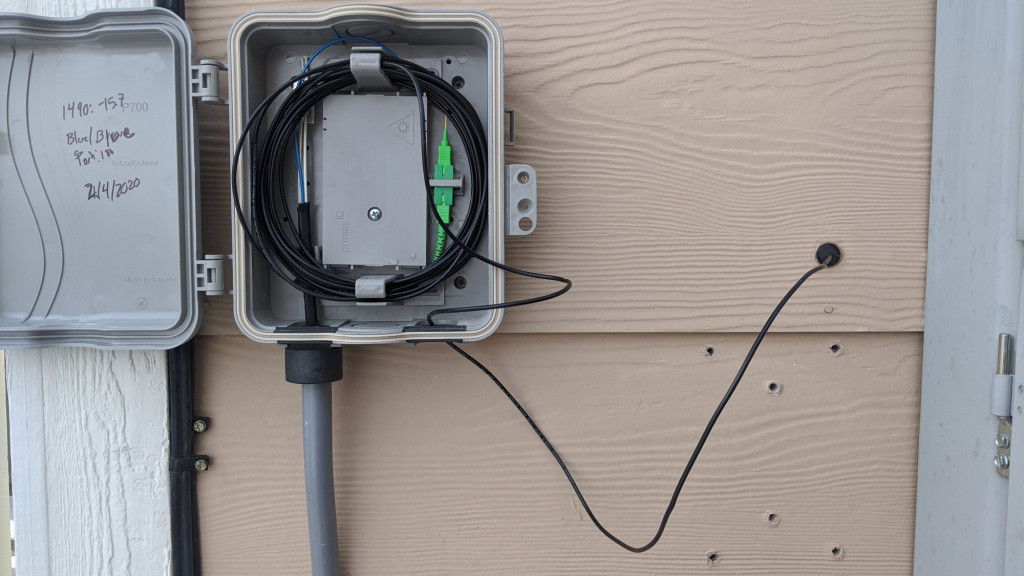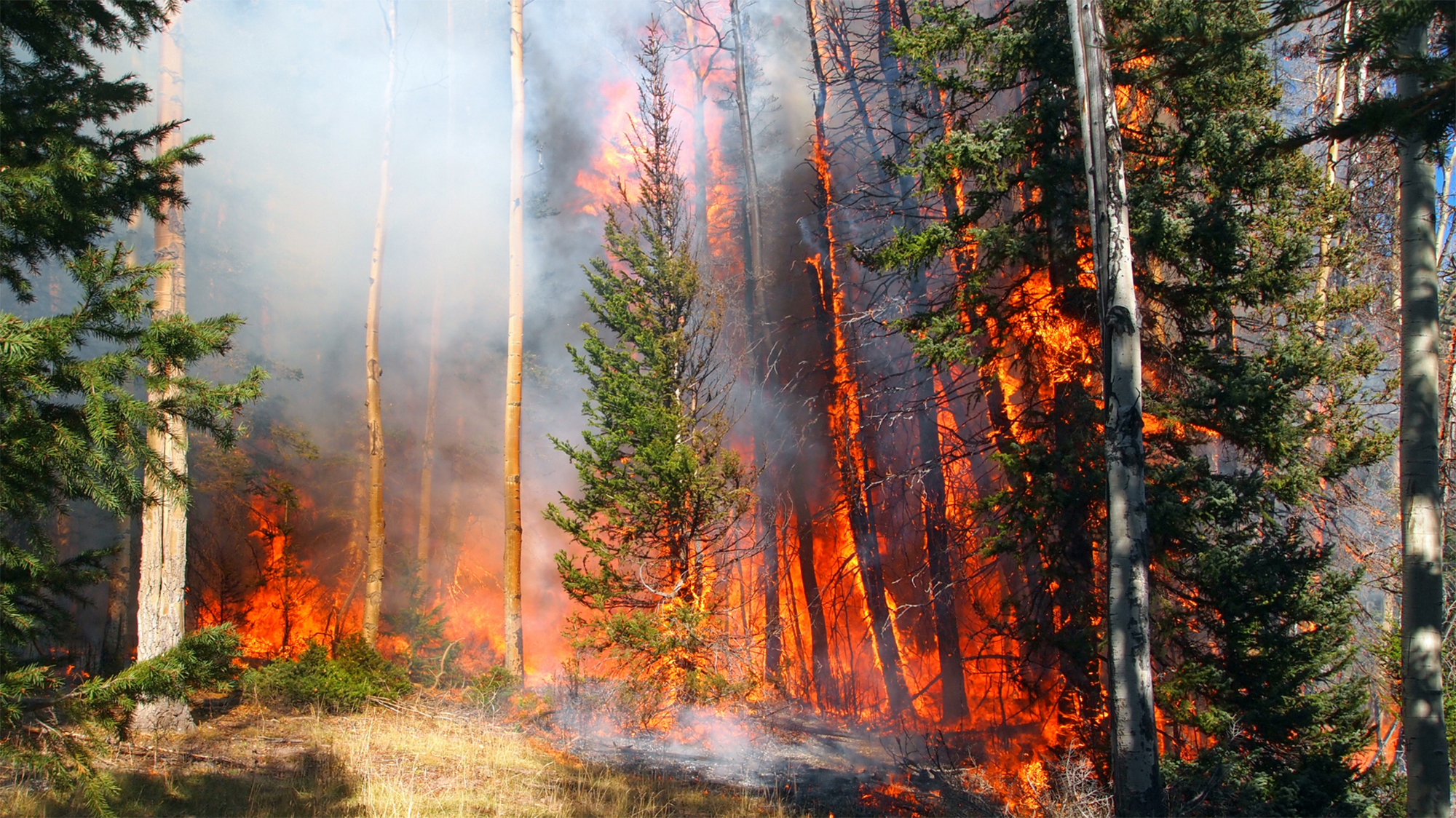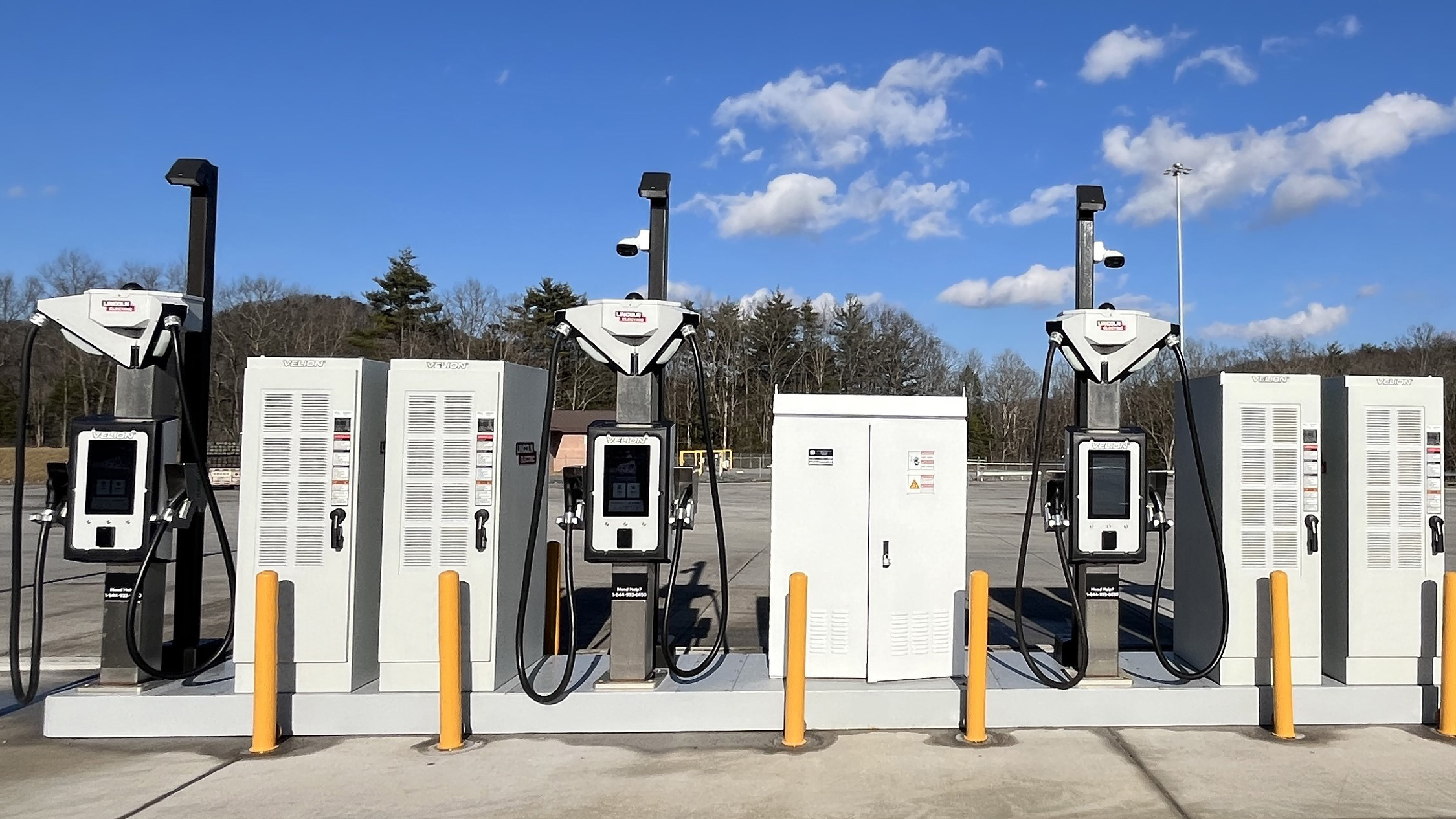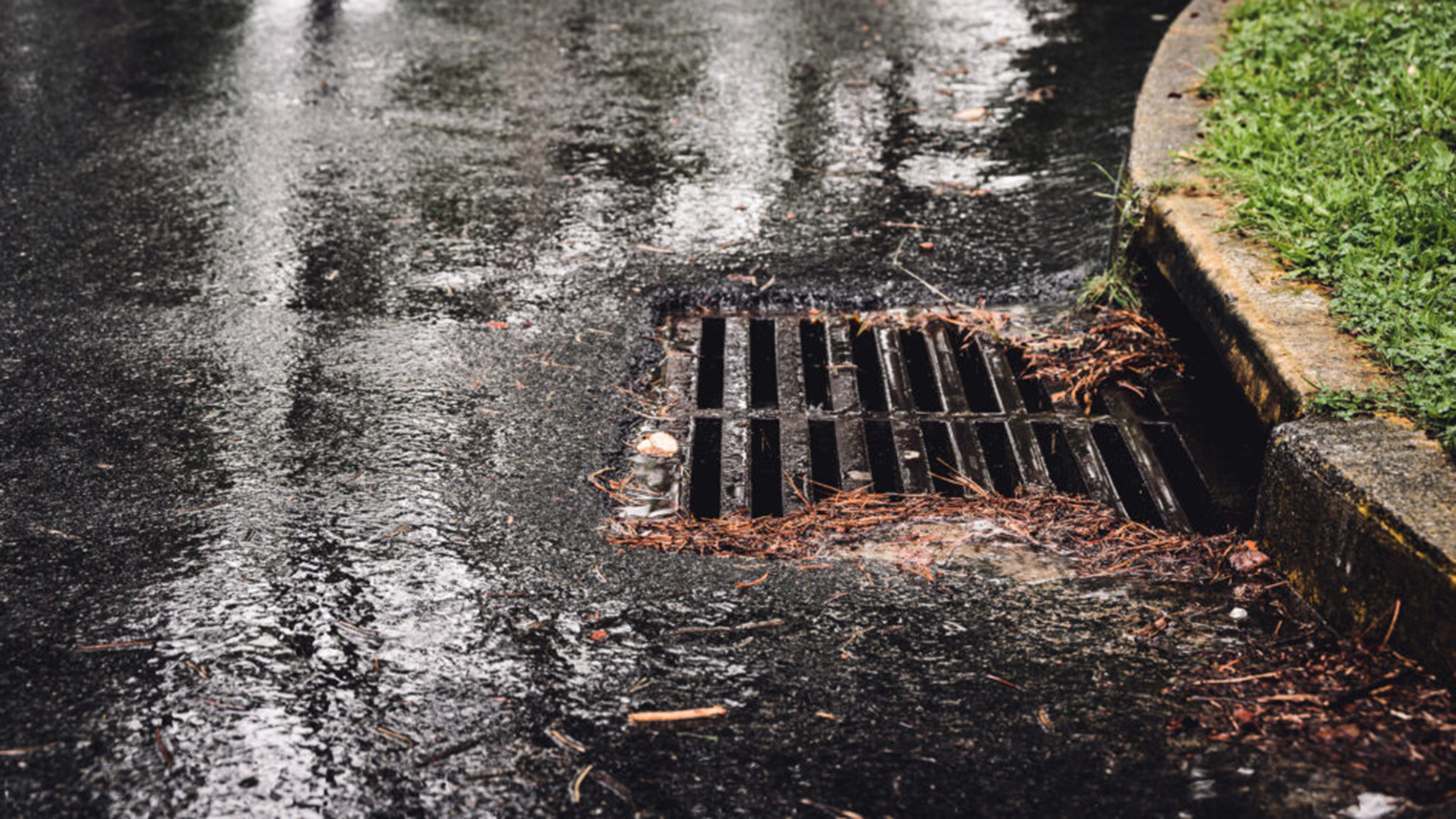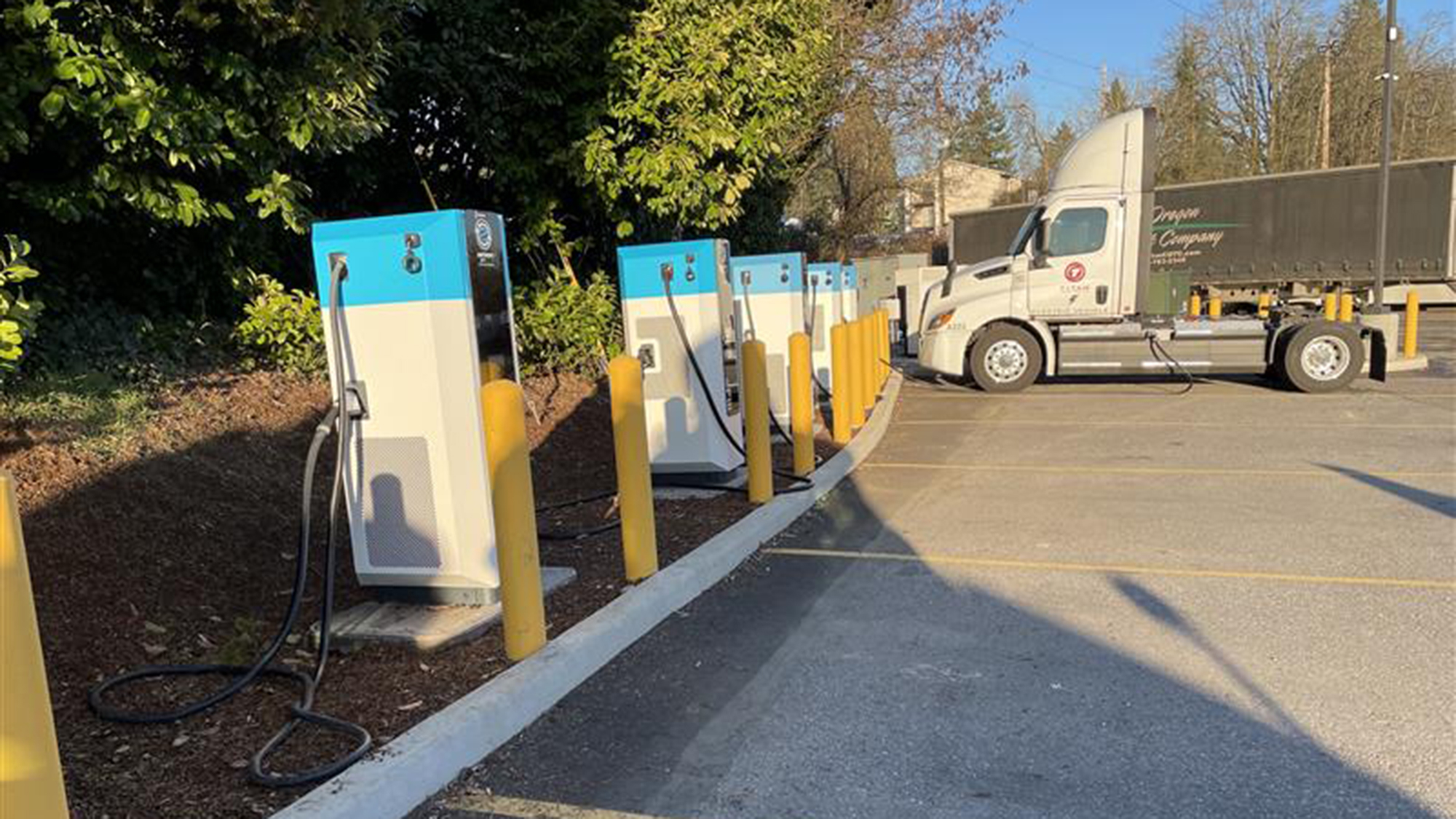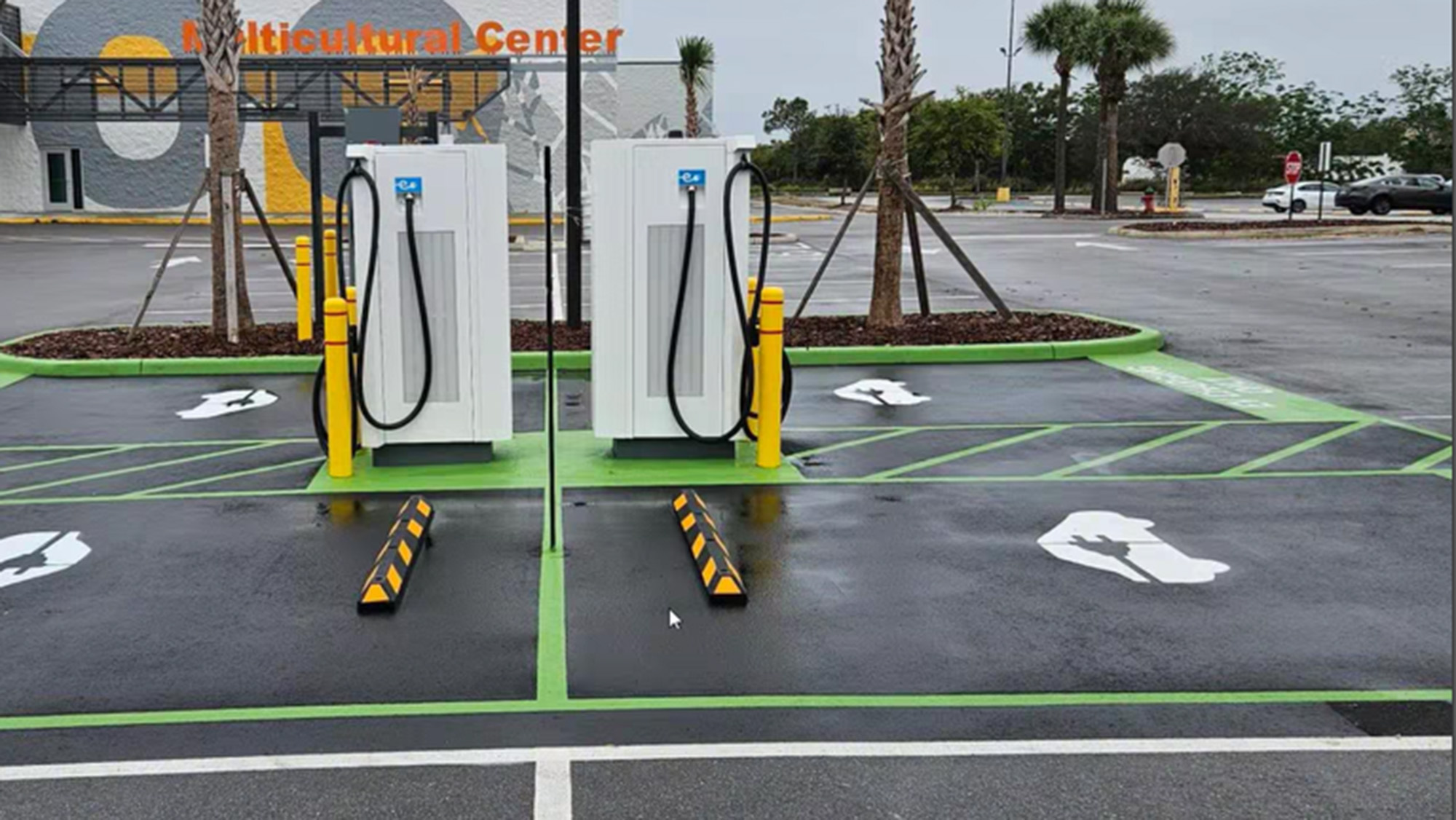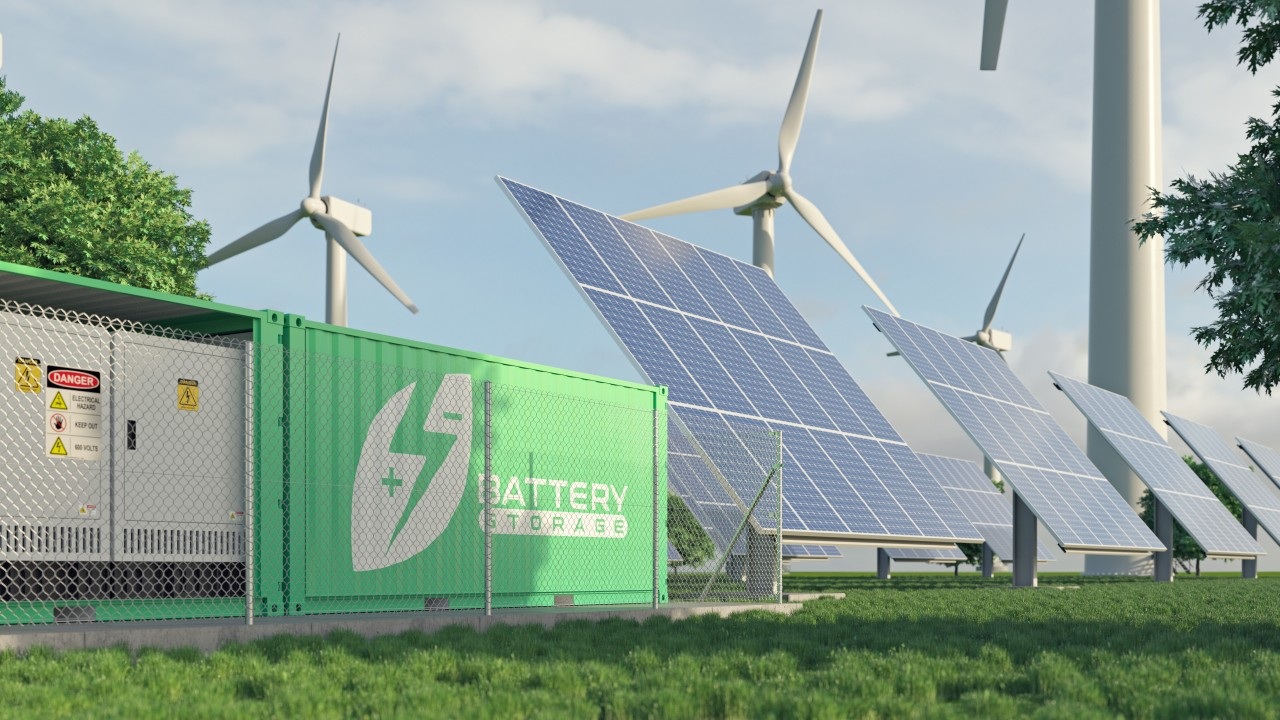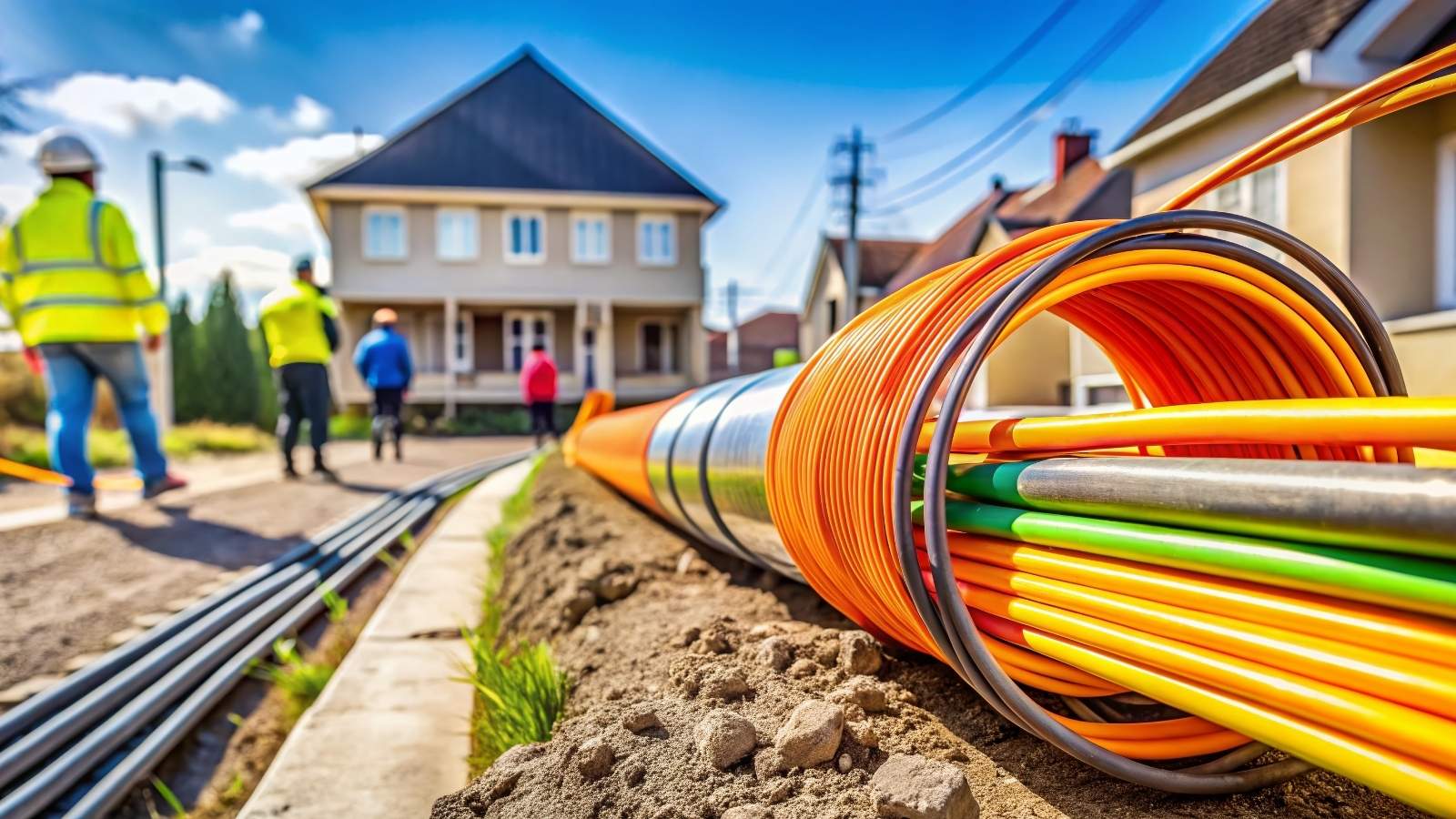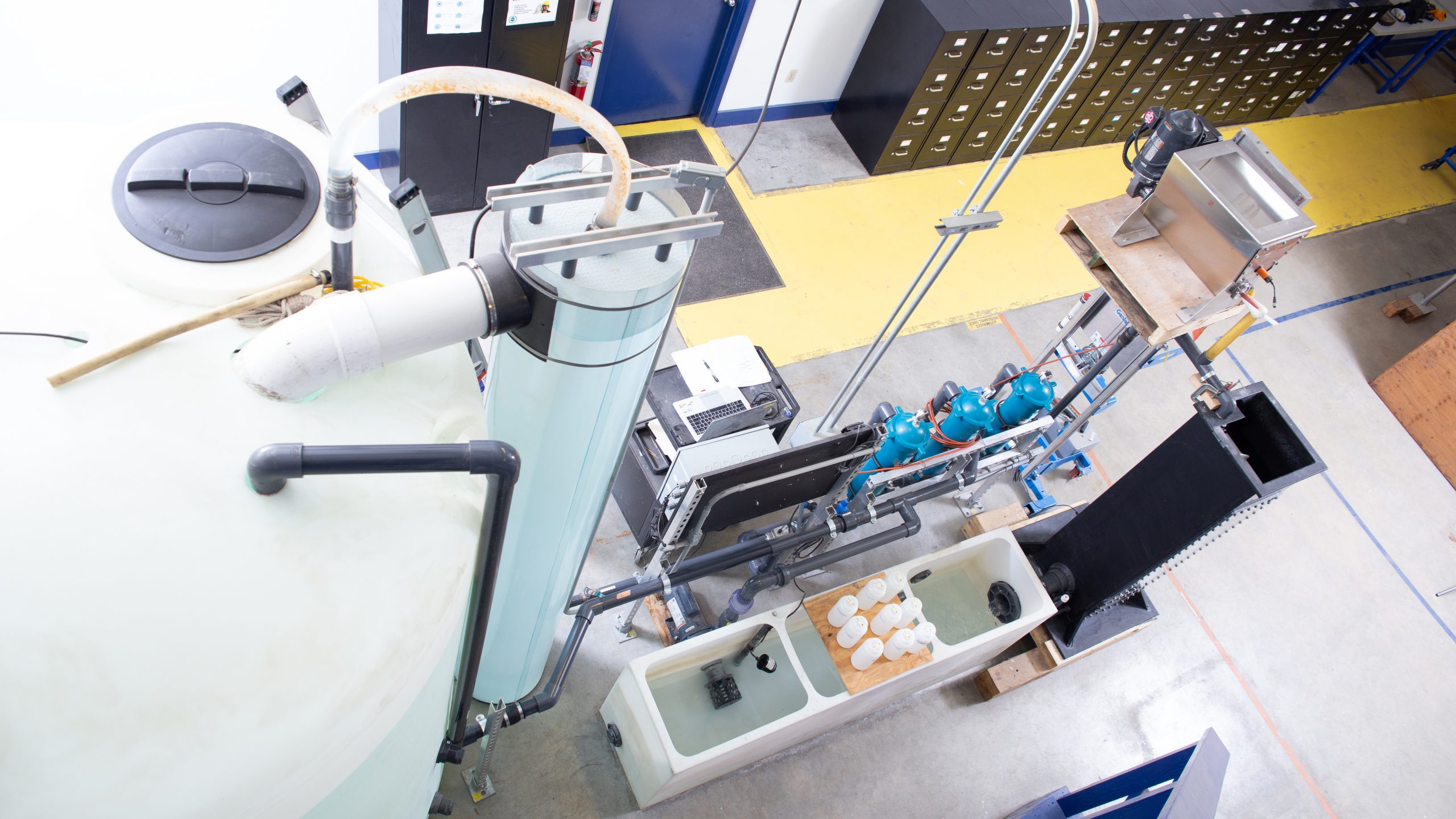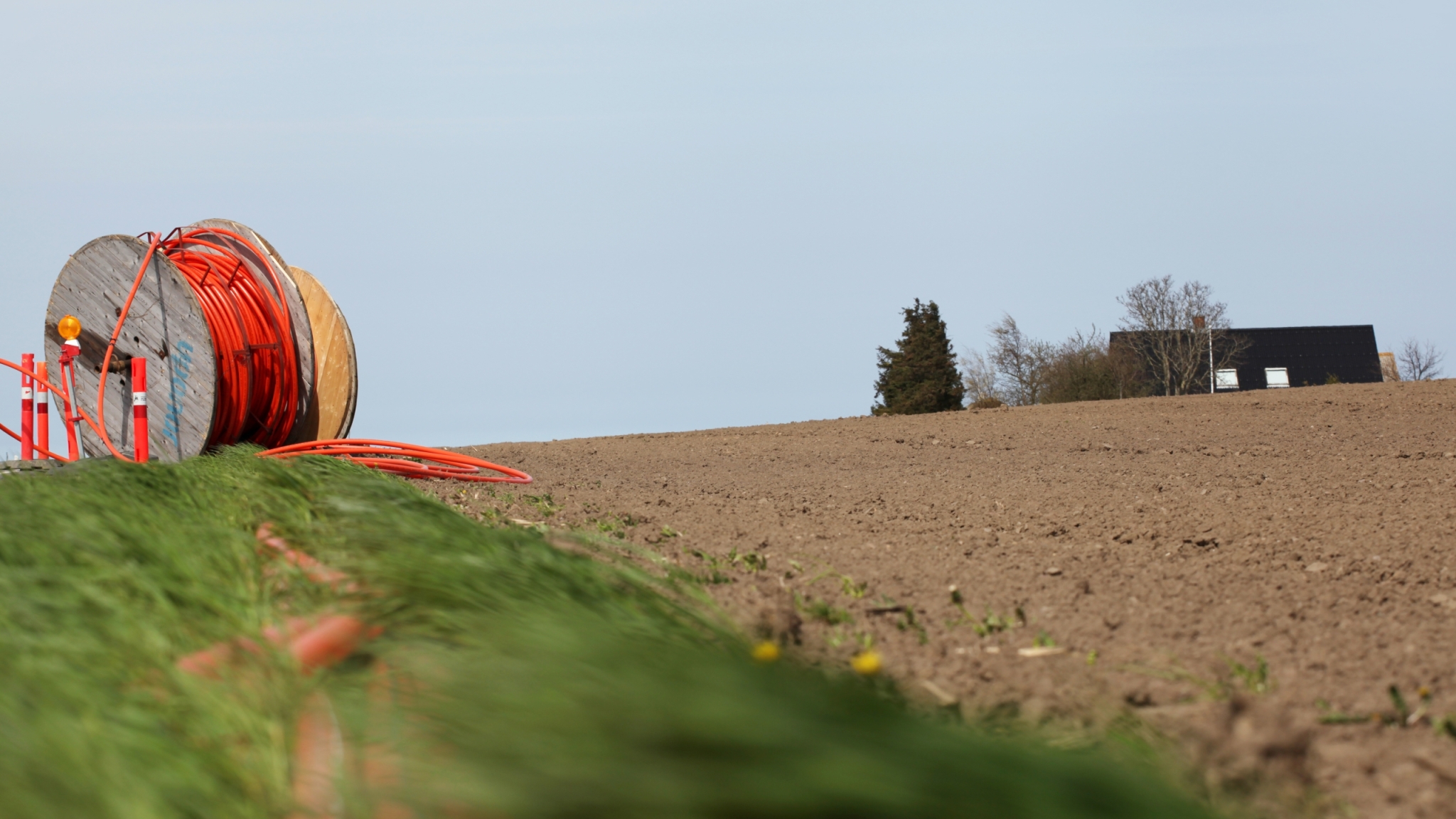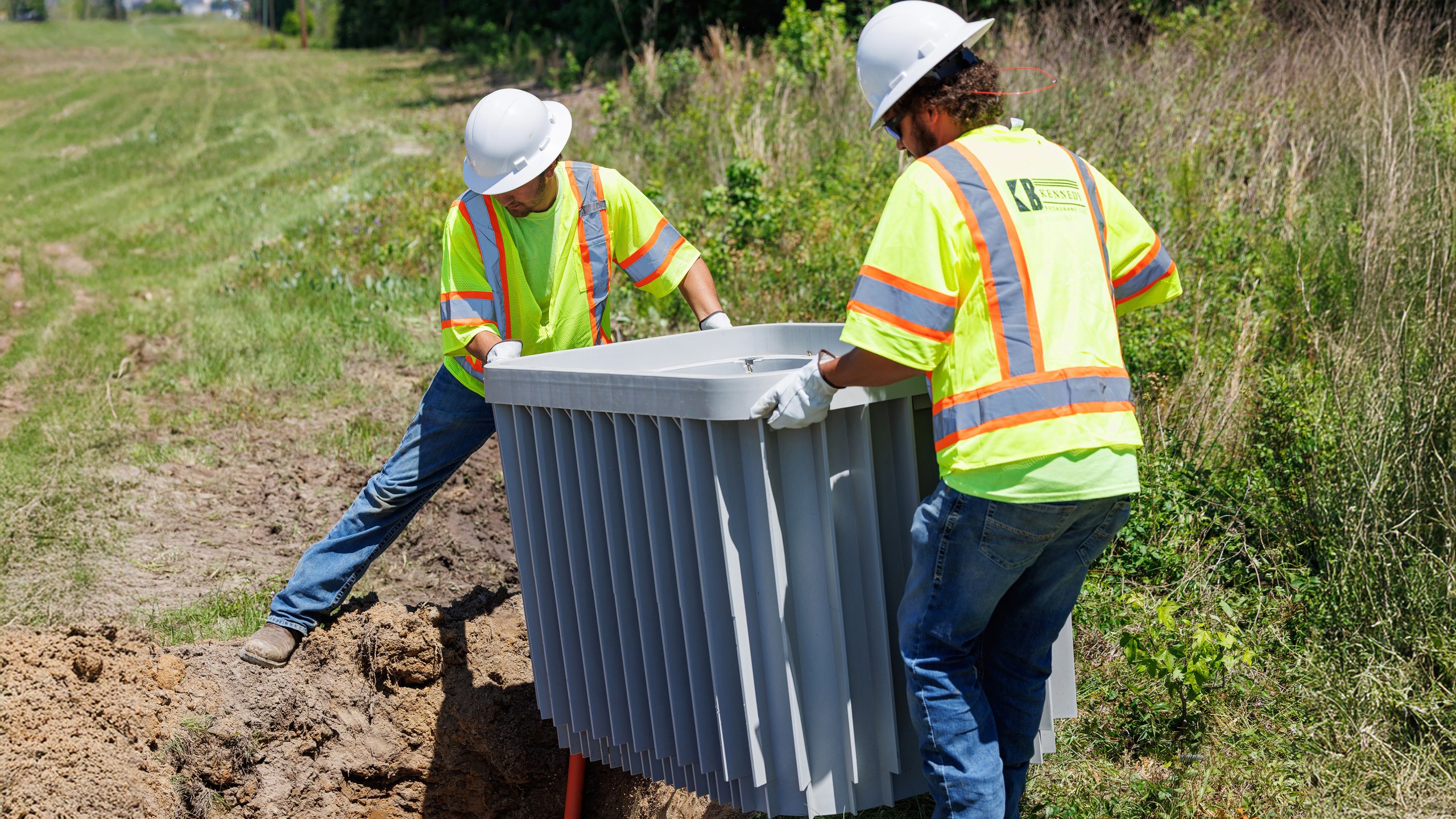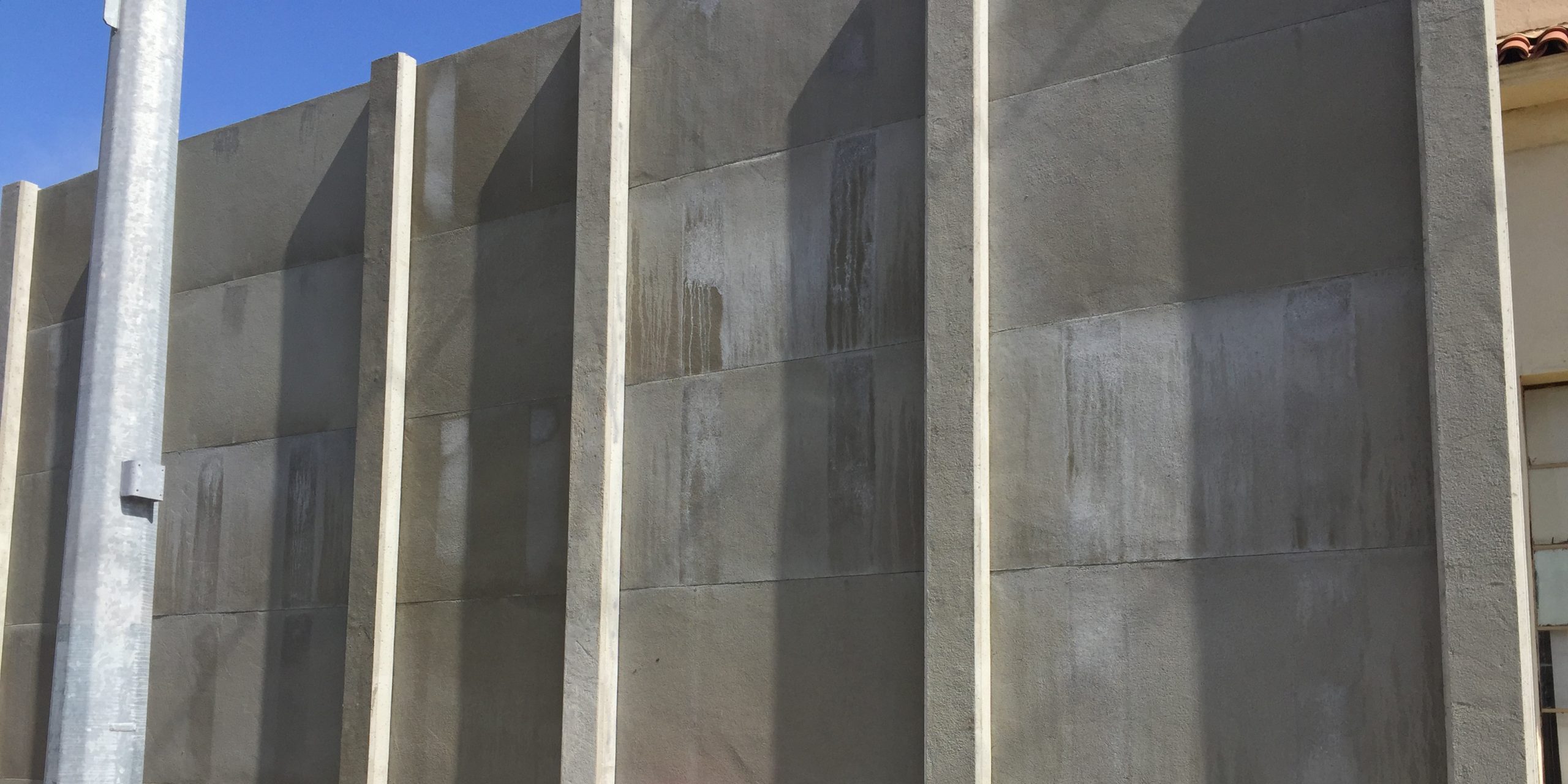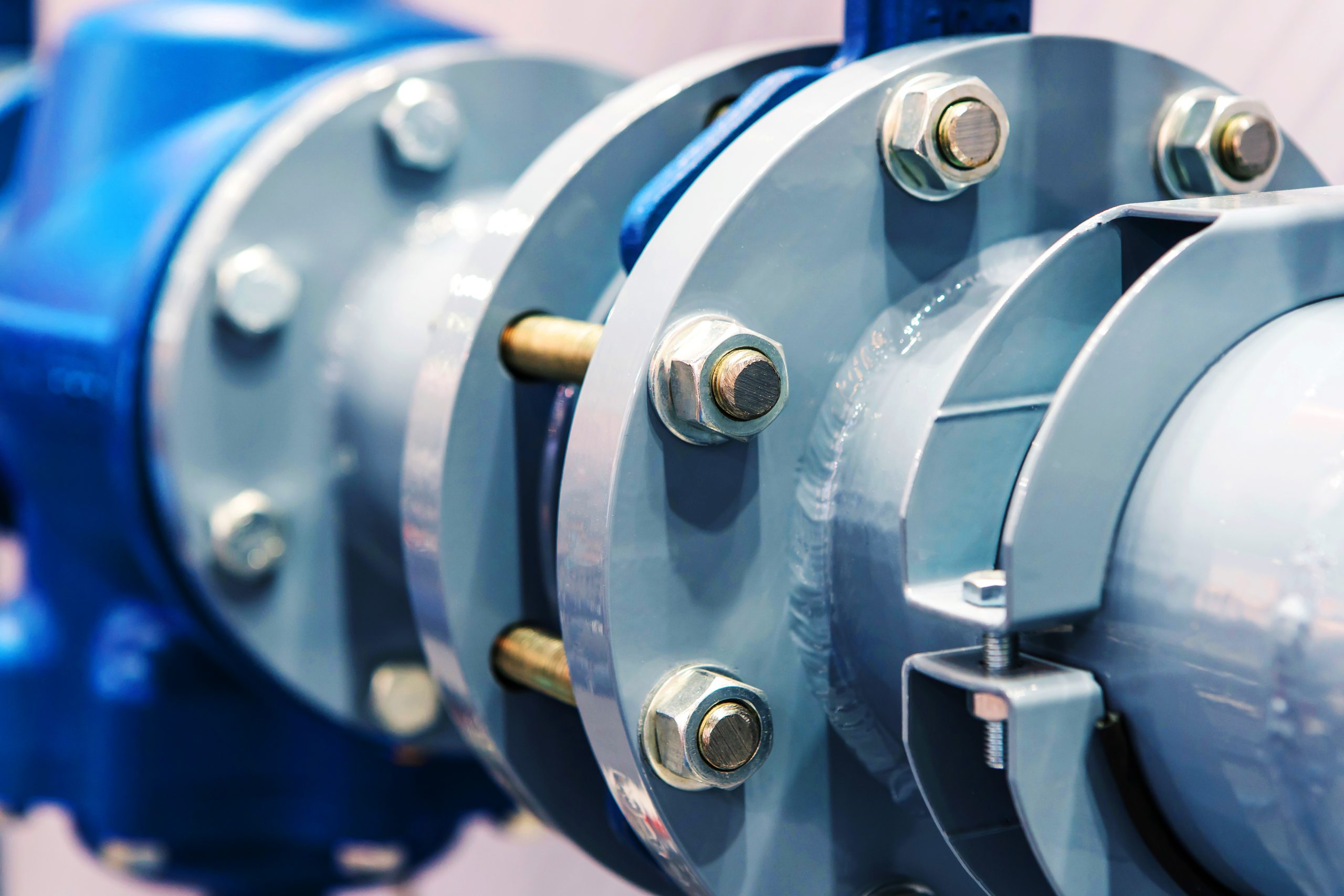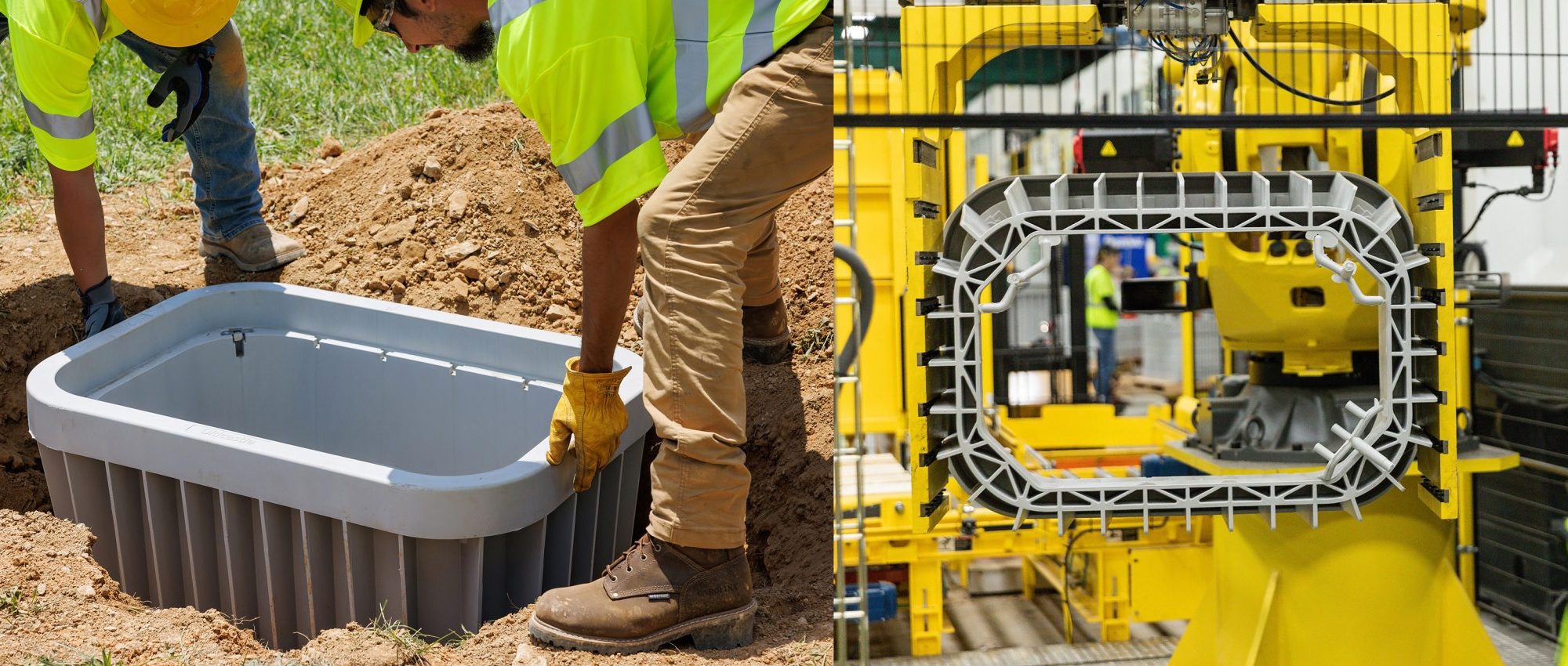The appetite for fiber Internet service is surging. As of 2024, 76.5 million homes across the United States are now connected with fiber to the Internet, marking a significant year-over-year increase. Such rapid expansion means a wide array of professionals, including builders, installers, engineers, architects, and service providers, are increasingly engaged in introducing fiber service to new residential developments and retrofitting existing structures. This task demands careful planning and a deep understanding of fiber architectures and their specific components.
As global demand for reliable broadband spikes, Oldcastle Infrastructure continues to lead with innovations that improve fiber-to-the-x (FTTx) deployments. Our broadband and connectivity solutions are crucial for developing efficient, scalable, resilient broadband infrastructure for modern digital landscapes and smart city projects.
The national push for widespread fiber deployment is not just about faster internet speeds; it’s about economic revitalization, healthcare access, educational opportunities, and bridging the digital divide. In areas still lacking adequate connectivity, Oldcastle’s strategic deployment practices are more than infrastructural developments; they are community lifelines.
An example is the Fort Collins project, which highlights how our integrated solutions extended broadband across multiple communities. For this project, the planners adopted a neighborhood-wide approach to fiber-to-the-home (FTTH) deployment instead of focusing on individual homes, as a highly efficient way to create the infrastructure. The incremental effort and cost required for an ISP or a technician to install fiber connections for multiple homes versus just one are relatively small. Yet, the rewards – such as heightened uptake of fiber packages once the infrastructure is established – are significant.
But navigating a neighborhood-wide FTTH deployment demands more than just a top-notch team. It also requires the proper installation to drive efficiency, minimize costs, and ensure the job gets done right the first time. The project required detailed planning and staged installations, with many Oldcastle products to comply with high-quality standards.
Integrating fiber optic technology is fundamental in evolving urban development. With the inclusion of our Primex product line, Oldcastle Infrastructure offers a broad spectrum of solutions to optimize FTTx installations. Our P350 OSP Enclosure, known for its straightforward installation and comprehensive cable management, and the FTC2 fiber wall plate, ideal for fiber interface inside the unit, exemplify adaptability and efficiency. The PR10 Media Panel is also a pivotal home connectivity hub particularly in retrofit situations, enhancing connectivity and accessibility. Service providers can use these dependable tools to ensure sustainable, cost-effective, high-speed internet access across diverse neighborhoods.
Oldcastle Infrastructure remains committed to delivering innovative tools and solutions that empower communities to succeed in the digital era. We’re here to help with FTTH projects across the US. Visit our communications solutions page to access a wealth of resources and discover our outside plant and premise connectivity product range.
Water is arguably the one asset that people take most for granted – until something goes wrong. Suddenly, it becomes expensive, scarce, and difficult to deliver. Smarter solutions make these invisible assets visible and enable city managers and water utilities to effectively tackle their critical aging infrastructure.
Water asset management: costly, complex and critical
Cities across the U.S. rely on three critical water systems to function properly:
- Stormwater networks that control runoff to manage flooding and reduce pollution in waterways
- Wastewater systems that collect, transport, and treat sewage
- Drinking water infrastructure that purifies and distributes clean water to homes, businesses, and industries
When one fails, the consequences ripple across communities.
Managing these assets has never been easy, but the task has become more complicated and costly. Climate change has intensified storms, putting additional pressures on municipalities in terms of coping with floods, mudslides and other weather-related hazards and uncertainties.
Wastewater demand fluctuates with population but becomes more expensive per capita as a community’s population and tax base drop.
As for drinking water, the losses to water main leaks and breaks are staggering. After first abstracting the water from boreholes, wells, rivers, and reservoirs, purifying it in costly filtering facilities, and sending it through a two-million-mile nationwide system of pipes, we lose about two trillion gallons a year…along with the $8 billion it costs to replace it.
As water systems become overwhelmed or break down, municipal water management leaders must wrestle with where to start as they confront aging infrastructure destined to cause significant problems in the near future.
To make matters worse, these underground assets remain invisible until failures surface – often when it’s too late.
Aging infrastructure: smarter solutions are needed
With aging infrastructure failing at an increasing rate, cities need smarter solutions.
Much of the water system in the U.S. was constructed right after World War II with an expected shelf-life of about 75 years, which means that most of the system is old beyond its time. There’s little question as to why so much of it is failing.
The ”out of sight, out of mind” nature of water loss fosters a reactive mindset among city officials and citizens alike. People in local government can agree that asset management – a comprehensive term for creating, maintaining, and updating a community’s infrastructure – is a difficult assignment. Like a homeowner postponing roof repairs, cities often delay maintenance – only to face high costs when problems become unavoidable.
The crisis of delayed maintenance for aging infrastructure is found all across the U.S., and the consequences are painful. Many communities are in a vicious downward spiral that will only get worse with ongoing failure to repair the systems.
In Jackson, MS, in 2002, a public health crisis followed the intersection of two disasters: water treatment plant infrastructure failure and river flooding. The result left 160,000 people, along with hospitals, fire stations and schools, without access to a safe supply of water. At the same time, Jackson’s water distribution system had numerous leaks and line breaks, with crews repairing five or six each day.
Stormwater itself brings miseries beyond the flooding of streets and neighborhoods. Surface water runoff is often laden with pollutants like trash, heavy metals, and bacteria that make further treatment necessary, complicated, and expensive. We see that in the Baltimore area, where aging sewer and stormwater infrastructure contributes to complications affecting a watershed that serves more than a million people.
CivilSense: making the invisible visible
Formidable obstacles stand in the way of solving the problem of aging infrastructure.
To begin with, it’s underground, hidden from easy observation and repair. When a bridge gets knocked down by a container ship or a cathedral burns out of control, the problem is readily seen and the solution obvious. But water loss is often impossible to see until the extensive damage is exposed by flooding in the streets or the water is shut off throughout entire neighborhoods.
A small puddle on the surface may be hundreds of feet from the actual source of the underground leak. What’s more, the size of the puddle tells you nothing about the size of the break. Until recently, the primary response has been with a shovel or backhoe and hours of digging.
Now, however, CivilSense™ makes sustainable water asset management efficient and effective by making the invisible visible.
Using a data-driven approach to sustainable water asset management that leverages cutting-edge technologies backed by more than 60 years of expertise and experience, city managers and water utility leaders now have a choice that pushes asset management far beyond the options that existed even as recently as last year.
New tools are available to diagnose and prioritize repair and maintenance budgets, which are only getting tighter and tighter. Real-time success stories illustrate that trusted expertise from Oldcastle Infrastructure’s team results in a near-immediate return on investment.
Investing in smarter water management today isn’t just necessary – it’s an economic imperative. With $625 billion needed over the next 20 years, solutions like CivilSense offer a way forward, delivering cost-effective, proactive asset management before crises strike.
Next
As a Thermoplastics Materials Engineer at Oldcastle, I am deeply involved in developing materials that offer protection in critical situations. My previous article highlighted how Duralite® was created to meet rigorous safety standards and flame resistance tests, all while promoting environmental sustainability. In this piece, I want to share why sustainability is personal to me—something I live every day, especially as I watch the ongoing California wildfires, which bring back vivid memories of the wildfires I’ve experienced in my home state of Oregon.
For me, sustainability is more than a goal—it’s a responsibility that extends far beyond product reliability or durability testing. It’s a mission to respond to the urgent need for a more sustainable world. And that need is more pressing than ever.
Sustainability is a term we hear frequently today. But for me—and for Oldcastle—it’s more than just a buzzword or a checkbox on a list. It’s a vital necessity that’s intricately connected to performance, and it’s woven into every step of our process: from research and development to manufacturing and distribution of products like our Duralite enclosures.
As climate-related events intensify, we feel an ever-growing sense of urgency to innovate in ways that protect our infrastructure—and the people who depend on it, including employees, customers, and communities. This urgency is what has driven us to engineer Duralite enclosures that pass rigorous Flame Spread and Enclosure Heat Protection tests. It’s also what motivates our shift from halogenated flame retardants to a safer phosphorus-based alternative that is better for the planet, its ecosystems, and its people.
Our Duralite composite body offers enhanced protection for critical infrastructure—like valves, switches, and electronics—shielding them from the devastating effects of wildfires. This, in turn, helps prevent water breaks, power outages, and ensures reliable control when it’s needed most. Each design update isn’t just an improvement—it’s a step toward a healthier, more sustainable future.
Duralite enclosures also deliver immediate safety benefits, thanks to their lighter weight and improved maneuverability, which reduce the risk of worker injury on job sites and in distribution centers. This focus on lighter weight and sustainability extends throughout Duralite’s entire life cycle, ensuring that safety and environmental impact are considered at every stage.
Products designed with sustainability in mind not only reduce harm in the short and long term, but they also contribute to a regenerative system where resources are reused rather than discarded. At Oldcastle, innovation and progress are inseparable from sustainability and safety, which is why I take my role as a Thermoplastics Materials Engineer so seriously.
To learn more about our lightweight composite enclosure, please visit our Duralite page.
As I woke up on Labor Day morning ready to make the most of the final days of summer, I looked outside and saw billowing sunlit smoke, the sign of a nearby forest fire threatening my city Portland, Oregon. It’s a stark reminder of the destructive power of wildfires and the importance of creating resilient solutions to protect our communities.
The recent California wildfires have weighed heavily on me, and at Oldcastle Infrastructure, we extend our deepest sympathies to the victims. They are a clear reminded of the Eagle Creek Fire where East winds carried the flames to the edge of Portland. It came with eye drying hot winds, ash like snow, and a total sense of helplessness as our forests burned.
As a Thermoplastics Materials Engineer at Oldcastle, I am intimately familiar with how we develop materials that protect us in critical situations. With the growing threat of wildfires, we knew we needed to create a material that was heat- and flame-resistant—the result: the Duralite® composite enclosure.
This first article explores how Duralite meets rigorous safety standards and flame resistance tests for better environmental sustainability. Featuring a thermoset composite lid and a composite plastic body, the enclosure passes the SCTE 77 Flame Spread and the Enclosure Heat Protection tests. This test involves burning the materials to measure the rate of burn and build a fire over the buried enclosure to measure the effects of heat inside.
In 2024, we transitioned from a brominated/halogenated flame retardant to a phosphorus-based flame retardant, because there’s growing evidence that halogen-free flame retardants (FRs) are safer for people and more sustainable for the environment.
Halogenated FRs are effective at preventing smoke and flames, but persist in the environment, bioaccumulate in the food chain, and disrupt endocrine systems, potentially leading to harmful health effects. Halogenated FRs break down slowly, accumulating in soil, water, and wildlife over time. As they move up the food chain, they can reach dangerous concentrations in predators. Studies suggest potential developmental, reproductive, and immune system impacts. When disposed of improperly, halogenated FRs can leach toxic chemicals into the environment, contributing to long-term pollution.
At Oldcastle, we strive to make products that meet the highest safety standards and contribute to environmental sustainability. While our Duralite composite body was designed to meet the load-bearing specifications of concrete alternatives, we’ve taken the extra step of using recycled plastic as the primary material. Blending recycled plastic with engineered additives achieves the required strength while reducing our environmental impact.
Our first successful Duralite bodies were made with some of the dirtiest recycled plastics— water bottle caps and closures. We rigorously test all incoming recycled materials to ensure our products meet or exceed performance standards. Compared to new plastic, recycled plastic emits 50% less greenhouse gas (GHG) per weight.
A Duralite enclosure is also significantly lighter than concrete alternatives and produces far fewer GHG emissions. We take a circular sustainability approach. When the enclosure reaches the end of its life, it can be ground up to create new products. We recycle our own Duralite process scrap to produce fresh enclosures. Duralite is not just a high-performance solution; it’s also the most sustainable choice available.
To learn more about our lightweight composite enclosure, please visit our Duralite page.
On January 23, 2025, the U.S. House of Representatives passed the Fix Our Forests Act, a bipartisan bill designed to reduce the risk of devastating wildfires. This legislation will help electric cooperatives by expediting federal approval for grid hardening and allowing the removal of hazardous vegetation that could fuel fires. Both measures aim to prevent future wildfire disasters.
In recent years, the U.S. has faced catastrophic wildfires causing billions in damages and displacing thousands of people. Many of these fires have been linked to electrical equipment failures or power lines sparking in areas overrun with vegetation. For instance, the 2018 Camp Fire in California, sparked by electrical transmission lines, tragically claimed 85 lives and destroyed the town of Paradise. Similarly, the 2023 Maui wildfires and the 2025 Palisades wildfires highlighted how failures in electrical systems and vegetation management can result in significant loss.
The Fix Our Forests Act aims to streamline the process for electric cooperatives to obtain federal permits to modernize their systems and enhance their resistance to wildfires. Currently, cooperatives can only remove vegetation within 10 feet of power lines and rights of way. This bill expands that limit to 150 feet, allowing them to proactively clear hazardous trees that could fall and spark fires. The bill now awaits approval from the Senate, which could be a critical step toward preventing future wildfires.
As wildfire activity and extreme heat waves become more frequent, electric utilities must prioritize fire resistance when selecting underground enclosures, especially in high-risk areas. The ANSI/SCTE 77 guidelines include flammability testing (Section 6.5) and internal equipment protection (Section 6.6) to assess how enclosures withstand fire exposure. Flammability tests (ASTM D635) measure how easily a product ignites and burns, while internal protection testing (USDA RUS 7 CFR 1755.910) ensures underground equipment remains functional in the event of a fire above the enclosure.
Oldcastle’s Duralite® enclosures exceed all industry standards for fire resistance and internal equipment protection. They maintain safe internal temperatures even when exposed to brushfire conditions exceeding 1,000°F. Duralite® has undergone third-party testing to meet GR-902-CORE, SCTE 77 2023, and USDA RUS 1755F 910 standards. By choosing fire-resistant enclosures, utilities can ensure long-term protection of underground assets, minimizing the risk of wildfire-related damage.
Bill Overview:
- Introduced by Rep. Bruce Westerman (R-AR) and Rep. Scott Peters (D-CA)
- Passed the House with bipartisan support (279-141)
- A previous version of the bill passed last September, but the Senate adjourned before acting. The current version now awaits Senate approval, which could be key in preventing future wildfire catastrophes.
As electric vehicles (EVs) become increasingly popular, the demand for a robust charging infrastructure is also growing. Traditional methods of building charging stations, especially in established sites, can be slow, costly, and disruptive. This creates delays in expanding the necessary charging networks. Platform-based designs for EV charging—like the DC-America platforms offered in partnership with Oldcastle Infrastructure—provide an innovative, faster, cost-effective, and scalable solution to meet the rising demand for charging stations.
Cost Efficiency and Faster Deployment
Platform-based designs bring significant savings in both cost and time. These prefabricated, standardized platforms eliminate the high costs typically associated with custom-built stations. They are flexible enough to fit various locations while meeting specific customer needs, offering a combination of affordability and adaptability. Standardizing platform sizes and manufacturing processes reduces material waste and lowers labor costs. This approach can reduce construction costs by up to 15% and cut installation time by as much as 50%, accelerating deployment and ensuring charging stations are installed where they’re most needed.
Simplified Engineering and Installation
Platform-based designs also streamline engineering and installation processes. Constructed with high-quality U.S.-made steel and featuring simplified electrical systems, these platforms reduce complexity. Most Electric Vehicle Supply Equipment (EVSE) uses similar designs, making wiring integration easier. The platforms include an enclosed raceway for electrical and communication cables and a single-point power connection, enhancing installation efficiency. This not only cuts labor costs but also speeds up the process, enabling stations to start operating sooner.
Reduced Site Work and Rapid Deployment
Traditional construction often requires extensive site preparation, including removing asphalt, pouring concrete, and laying conduit. Platform-based designs require minimal site preparation, significantly reducing installation time and costs. Additionally, they reduce material waste and environmental impact. Since these platforms are pre-manufactured and pre-commissioned in climate-controlled facilities, weather conditions are less likely to delay installation, making the process more reliable.
One of the key benefits of platform-based depots is their rapid deployment. Delivered as fully assembled units, these platforms only need to be offloaded, set in place, and anchored. This process can be completed within hours, with minimal disruption to the surrounding area. The quick setup accelerates return on investment (ROI) and ensures that charging stations are operational almost immediately.
Scalability and Future-Proofing
In addition to being cost-effective and fast, platform-based depots are scalable and adaptable to future needs. These systems can easily be relocated, expanded, or upgraded as demand increases or as new technologies emerge. Operators can add new platforms to increase the number of chargers or upgrade existing ones to accommodate future advancements in charging technology. The modular design also allows for easy equipment replacement without requiring extensive demolition, ensuring the long-term sustainability of the infrastructure.
Moreover, platform-based depots offer ample customization options, including features such as lighting, cameras, and photovoltaic canopies, which enhance the user experience and further reduce construction time and costs. This flexibility ensures that charging stations remain efficient, functional, and adaptable for years to come.
A Critical Role in EV Infrastructure Expansion
As the EV market grows, platform-based depots will play a crucial role in expanding the charging infrastructure. These systems provide a cost-effective, efficient, and scalable solution that accelerates deployment while minimizing disruption to the surrounding environment. Innovations like the DC-America platform, in partnership with Oldcastle Infrastructure, are helping deliver faster ROI, shorter installation times, and long-term sustainability.
Platform-based EV charging depots are helping create a more accessible and efficient transportation network, ensuring that the growing needs of the electric vehicle market are met with speed, affordability, and future-proof flexibility.
We’re here to help with your EV charging projects across the US. Visit EV Charging Infrastructure Solutions Center to access a wealth of resources and discover our extensive and adaptable product range.
The importance of stormwater maintenance
When it comes to stormwater treatment, much emphasis is given to performance. Testing verification and protocols such as New Jersey’s NJCAT and Washington’s TAPE assess the pollutant removal rates of stormwater separators and filters, and they provide valuable like-for-like comparisons that assist engineers in specifying the most effective treatment solution for the site.
However, the stated performance of any system is contingent on the operating condition of that system.
The Prussian general Helmuth von Moltke once suggested that “no plan survives first contact with the enemy”, and I think a similar principle may be applied here: no unmaintained stormwater treatment system survives extended contact with the real world.
What do I mean by that? Simply put, a typical surface water treatment system is designed to capture and remove pollutant materials from stormwater. This ranges from trash and gross solids to nutrients, heavy metals and hydrocarbons, all while having defined storage capacity for these materials. If left unattended, it will eventually fill and its capacity to store pollutants will be lost. Its performance will drop to zero, and it could eventually create a flood risk by preventing water from flowing at all.
All stormwater systems need to be maintained—green or grey, natural or engineered—and ironically, the better the system performs, the faster it will fill up.
So while performance is the fundamental characteristic of any stormwater treatment system, without regular maintenance, that performance eventually means nothing.
Maintenance: a shared responsibility
Responsibility for the operation and maintenance of a surface water treatment system ultimately lies with the site owner, but they are often unaware that they even own such a system.
The consultants, design engineers and contractors who deliver the project are custodians of the site before and during development, and as such they share a duty to ensure that the site that they pass on meets all necessary regulations—now and in the future.
Engineers in particular are uniquely placed to position a site for long-term environmental compliance. The lifetime of a stormwater treatment system is measured in decades, so the selection of that system will determine how effectively stormwater is managed on the site for many years.
The engineer has a delicate task, having to balance client expectations against regulatory compliance and cost effectiveness against performance. It would be easy to sacrifice long-term performance for short-term benefit. Fortunately, however, modern systems such as the Hydro-Shield™ Advance hydrodynamic separator are increasingly engineered to operate in a sweet spot that provides affordable high-performance treatment with quick, easy maintenance.
Contractors also bear responsibility for handing over a site that is optimized for effective long-term stormwater management, and they can benefit from doing so. More and more construction companies are recognizing that sustainable development and environmental stewardship are valued by shareholders, employees and the communities in which they live and work. Demonstrating that procurement decisions have been made with sustainability in mind has both environmental and commercial benefits.
How to maximize stormwater treatment operating efficiency
Maintenance is often thought of as a post-install responsibility, but engineers and project owners should keep operating efficiency and system lifetimes in mind from the very start.
Good project operation and efficient maintenance begin with design and continue through installation, and these aspects are influenced by decisions made and actions taken early on in the project.
Adopting the following three principles at early and intermediate stages of the project will help to maximize the operating efficiency of the stormwater treatment systems for the lifetime of the site development.
Design stormwater with maintenance in mind
Stormwater regulations persist for the lifetime of the site, so engineers should optimize the design of the site so that the site owner is enabled and empowered to remain compliant with regulations and protect the local environment from surface water pollution for the lifetime of the site development.
Clearly engineers approach the design process with regulations and performance at front of mind, but optimizing for lifetime performance means going beyond that. Not only should the stormwater management systems themselves be quick, easy and safe to maintain, but the site overall should accommodate maintenance in a way that does not impinge on that.
Site features and components should improve—or at the very least not hinder—access for ongoing maintenance. Vehicle access should be safe and secure, for example, and wherever possible, maintenance access points should be sited in such a way that maintenance vehicles do not block or impede road users or pedestrians.
Safety should also be paramount. Maintenance work can be risky, so particular attention should be paid to systems and features that remove, minimize or mitigate risk to maintenance workers and the public. Access to stormwater systems should be quick and simple, and engineers should prioritize systems that limit the time that maintenance personnel spend in confined spaces or operating machinery. Ease and speed of maintenance are key.
Develop an effective maintenance plan
Site plans governing the operation and maintenance of surface water management systems on site are an essential tool for the owner, engineer and contractor alike—and in fact may be required by local planning regulations.
As part of the site development process, the engineer and contractor should develop a maintenance plan or operation and maintenance (O&M) manual. This document will provide site owners with all the information that they need in order to monitor, clean, repair or replace any parts of their stormwater management system necessary to remain compliant.
Indeed, the EPA recommends that any stormwater maintenance plan clearly defines who is responsible for maintenance, what maintenance activities are required and how frequently they are carried out, what level of funding is required, and so on. Individual states may also provide their own recommendations or templates based on local requirements.
The plan should provide a site owner with all necessary information required to inspect, operate and maintain stormwater management infrastructure. This should include maintenance requirements for component parts, schedules for inspections and site visits and instructions on how to report and record repairs.
The plan can also help the owner budget for the required maintenance, to prevent any financial surprises down the line. Most manufactured treatment devices have O&M manuals that can form the basis for such a plan.
This plan should form part of a site handover, giving owners a clear step-by-step guide to maximizing system performance and operating efficiency for the duration of its lifetime.
Use handover as an opportunity to add value
Stormwater treatment systems are often one of the first components of a development to be installed, sometimes a number of years before completion of the overall project. Typically they are underground, and the owner is likely to be distanced from the project due to there being a substantial number of other parties involved. When it comes time to take ownership of the site they are likely to have a range of other competing priorities.
As the subject-matter experts, prior to and during handover, consultants and designers should take the opportunity to underline to the owner the importance of carrying out the correct maintenance of the system. Proper maintenance supports both the expected performance and lifespan of the system.
Site owners are likely not to be experts in stormwater management, so engineers can provide value by educating the owner on the need for maintenance. They can recommend that maintenance be overseen or carried out by a party with knowledge or expertise of stormwater management.
They may also advise that the equipment manufacturer provide expert inspections for an initial period while the site owner manages a newly completed project. We recommend scheduling regular inspections on stormwater treatment systems for a minimum of two years after installation.
Finally, it is common for systems to be “lost” after construction, and for owners to be completely unaware of them. Owners and regulatory inspectors rarely own the original drawings and plans. Engineers can benefit all involved by pushing for all installed systems to be captured in a geographic information system (GIS) to eliminate this knowledge gap and aid in regulatory compliance.
Conclusion
Undertaking the correct maintenance program is the most cost-effective long-term approach for the site owner. Maintaining the stormwater treatment systems installed on their site helps the owner to avoid costly fines, bad publicity and legal issues resulting from non-compliance with regulations.
By outlining these risks and helping the owner to plan to mitigate them, engineers provide additional value to clients, partners, and the public and position themselves to win further business.
Next
In my previous article, I delved on the differences in quality and control, speed of installation, labor resources and risk concerns between pre-cast and cast-in-place (CIP) construction methods. This article focuses on the vast difference between price and total cost of ownership (TCO) and why it is an important consideration when planning EV charging projects.
While precast solutions may come with a higher upfront cost, it often results in significant long-term savings. For example, while the material and installation cost for a precast underground structure might higher, the TCO of CIP may start much lower but increase when accounting for the additional time and labor required. The extra days of work required for CIP—due to pouring, curing, and finishing—adds not only labor costs but also general conditions costs (supervision, insurance, jobsite overhead, etc.).
We estimate an average of about 20 percent savings in a double pad installation:
Cost Comparison of Precast to Cast-in-Place EV Charging Double Pad Installation
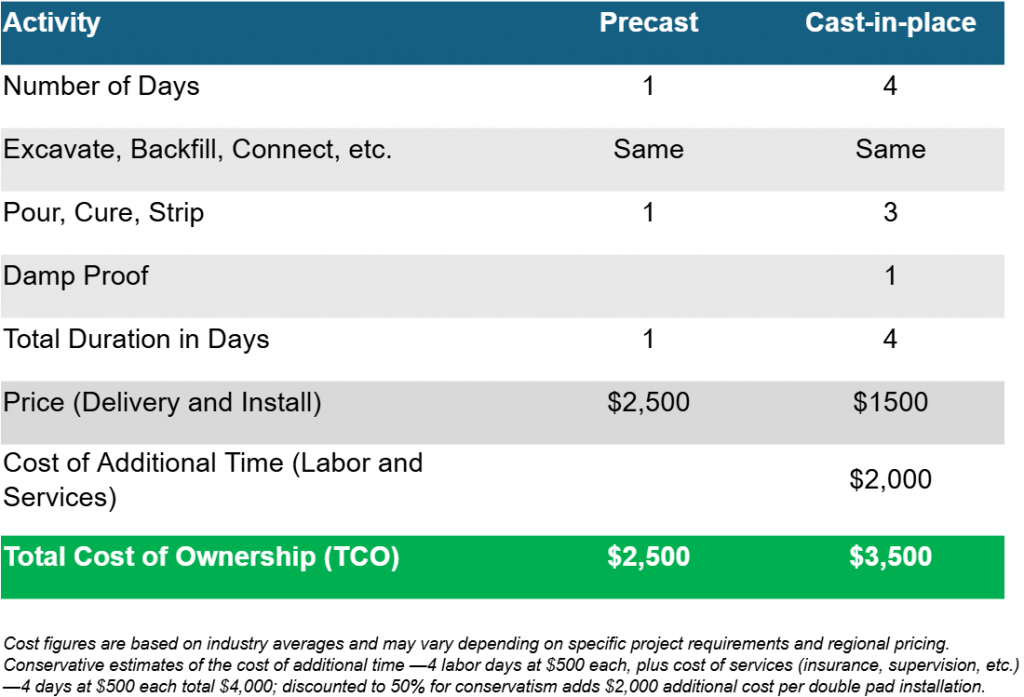
In this example, even if CIP seems cheaper initially, the TCO ends up being higher due to extended project timelines and the added risk of delays or errors. Precast product’s faster installation helps save on additional time costs, and for contractors, every saved day equates to increased profitability.
Real-World Example: Cost Breakdown
Consider the above example of installing a double pad underground structure for an EV charging station. A precast unit would cost on average $1,500, with an additional $1,000 for crane services. Installation is completed in one day, including backfill, with no curing time required. On the other hand, CIP for the same structure, requiring labor for multiple pours, curing, and damp proofing, totals $1,500 for the materials alone, but the TCO increases once you factor in the extra time and labor.
Saving this extra time and labor means additional profit for the contractor and faster monetization for the site owner. When considering general condition costs, this savings could rise further. Precast offers a substantial reduction in the total cost compared to CIP, with potential higher savings depending on weather
Precast is the Better Choice
While CIP may offer advantages in certain cases—such as highly customized designs or challenging site conditions—precast solutions generally provides a better value for EV charging installations. The time savings, reduced labor, consistent quality, and lower TCO make precast the more efficient, cost-effective solution in most cases. When choosing between these two methods, contractors and specifiers should focus on the total cost of ownership rather than just the upfront price, recognizing that precast offers long-term savings that far outweigh its initial cost.
We’re here to help with your EV charging projects across the US. Visit EV Charging Infrastructure Solutions Center to access a wealth of resources and discover our extensive and adaptable product range.
When planning the installation of electric vehicle (EV) charging stations, selecting between precast solutions and cast-in-place (CIP) is a crucial decision that influences both immediate expenses and long-term value. This choice requires a comprehensive understanding of the Total Cost of Ownership (TCO), encompassing four key components: quality, installation, delivery, and upfront cost.
This article focuses on differences in quality and control, speed of installation, and labor and risk considerations. The next article in this series will offer a comparison between price and TCO.
Understanding Total Cost of Ownership (TCO)
TCO extends beyond the initial material costs to include all expenses over the project’s lifespan. It comprises:
- Quality: The durability and reliability of the concrete, impacting long-term performance.
- Installation: The efficiency of the installation process, including labor requirements and construction scheduling.
- Delivery: The time taken to receive materials on-site and complete the installation.
- Upfront Cost: The cost of materials and installation.
While precast solutions may have a higher upfront cost compared to CIP, the other TCO components often make it the more advantageous choice when evaluating long-term costs.
Quality and Control
Precast offer superior quality control during manufacturing. Produced in a controlled factory environment, precast products ensure consistent strength, durability, and dimensional accuracy. This process eliminates the variability and potential issues associated with CIP, where factors such as weather conditions, on-site mixing, and curing times can affect the final product’s quality.
For EV charging installations, where durability and reliability are paramount, precast solutions ensure the structure will withstand wear and tear over time. In contrast, CIP concrete, poured and cured on-site, is more susceptible to unpredictable elements, leading to a higher risk of defects or the need for repairs down the line.
Speed of Installation and Time Savings
Precast solutions offer significant time savings over CIP. Precast components are manufactured off-site and delivered ready to install, allowing for a quicker installation process without the need for curing or formwork setup. For an EV charging station, which may require a quick turnaround, the reduced time spent on-site can be a major advantage, enabling more installations per day to shorten project timelines.
In a typical precast installation, delivery and installation can be completed in just one day, while CIP may take up to seven days due to the time required for pouring, curing, and stripping the forms. The time savings associated with precast not only accelerate the project timeline but also reduce the risk of delays and associated costs, such as extended labor and equipment rentals.
Reduced Labor and Risk
Precast solutions reduce the amount of labor needed on-site, as the components are pre-made and simply require lifting and positioning. This reduces the complexity of the construction process, minimizing the potential for errors and delays. One typical error encountered is concrete poured on incorrect rough-in of conduits and anchors.
CIP, however, requires more on-site labor, including formwork setup, pouring, finishing, and curing. Additionally, the construction schedule is more unpredictable, as it is subject to weather and other environmental factors, any unexpected rain fall could delay installation for the day or affect the curing of any CIP concrete poured prior to the rain fall. For EV charging stations, where downtime can disrupt service, using precast products ensures faster deployment, reducing potential loss of business.
We’re here to help with your EV charging projects across the US. Visit EV Charging Infrastructure Solutions Center to access a wealth of resources and discover our extensive and adaptable product range.
As renewable energy generation expands, the need for a more flexible, resilient, and efficient U.S. energy grid has become urgent. The shift toward cleaner energy sources like solar and wind is reshaping the grid, creating both challenges and opportunities.
While the first Trump administration focused on deregulation and energy independence through fossil fuels, it also recognized the importance of renewables like wind and solar, supporting their growth through incentives such as the Production Tax Credit (PTC) and Investment Tax Credit (ITC). Continued support for these sectors will be essential to ensure that the grid can accommodate the increasing influx of clean energy.
Challenges of Geographic Mismatch in Renewable Energy Generation
Renewables like solar and wind are often generated in remote areas far from population centers, creating challenges in transporting energy efficiently over long distances. During the first Trump administration, infrastructure investments primarily targeted traditional energy sectors, but the transition to a cleaner energy future necessitates substantial upgrades to grid infrastructure.
A modernized grid, incorporating technologies like smart grids, will be vital for managing the intermittent nature of renewable energy and ensuring that renewable electricity can be delivered reliably to consumers. Innovations like real-time monitoring, predictive analytics, and automated responses will enhance grid efficiency and resilience.
The Role of Energy Storage in Grid Modernization
Energy storage is key to overcoming the challenge of renewable energy intermittency. The first Trump administration had mixed policies regarding energy storage, but the demand for advanced storage solutions has grown alongside the expansion of renewables.
Energy storage systems allow excess energy generated during peak renewable production to be stored for later use when production is low. Battery storage, along with other technologies, helps smooth out fluctuations in supply, making the grid more reliable.
As storage costs continue to decline, large-scale storage projects are increasingly being implemented across the U.S. This integration will be essential for ensuring that clean energy can meet demand at all times.
The Growing Demand for Electricity: EVs and Data Centers
In addition to traditional energy demands, the growing need for electricity from electric vehicles (EVs) and data centers presents new challenges for the grid. EVs are expected to make up a large portion of transportation in the coming decades and will require substantial amounts of energy for charging. Similarly, the rise of data centers—critical infrastructure for the digital economy—will further strain the grid.
The increasing importance of renewable energy for these sectors underscores the need for grid adaptations that integrate sustainable power sources to meet future demands.
State-Level Renewable Energy Goals and Grid Challenges
Many states across the U.S. have set ambitious renewable energy targets, with some aiming for 100% renewable energy portfolios. As these state-level goals advance, grid operators face the challenge of managing the growing influx of renewable energy while maintaining grid stability and reliability.
Ensuring that the grid can handle both the quantity and variability of renewable energy will require significant infrastructure investment, technological upgrades, and collaboration between utilities, regulators, and developers. Successfully integrating renewables without compromising grid performance will be a critical priority as state-level goals progress.
Preparing the U.S. Grid for a Sustainable Future
The future of the U.S. energy grid will require extensive collaboration and ongoing technological innovation. As renewable energy becomes a more significant part of the U.S. energy mix, the grid must be modernized to support these sources. This includes the integration of solar, wind, and storage systems while accommodating new demands like electric vehicles and data centers.
To achieve this, continued investments in grid infrastructure, energy storage solutions, and smart grid technologies will be essential. With the right policies and investments, the U.S. can build a grid capable of supporting a clean, secure, and sustainable energy future that meets the needs of both current and future electricity consumers.
Oldcastle Infrastructure is your partner in renewable energy infrastructure projects. Explore our energy solutions designed to power projects toward a sustainable, electric-powered future at: Manufacturer of Electric, Oil, & Gas Utility Infrastructure Precast & Enclosure Solutions | Oldcastle Infrastructure
Utilities are central to the U.S. renewable energy transition, with a growing emphasis on clean energy driven by favorable economic conditions, supportive policies, and increasing demand for sustainable energy.
Meeting the Growing Demand for Clean Energy
The transition to renewable energy is heavily driven by growing consumer demand. As individuals and businesses seek to reduce their carbon footprints, utilities are pressured to offer cleaner energy options. This consumer-driven demand pushes utilities to accelerate their renewable energy investments, which helps them meet renewable portfolio standards (RPS) and clean energy standards (CES) set by individual states and at the federal level.
Additionally, utilities are under increasing pressure from investors and stakeholders to shift their energy mix toward renewables. The growing emphasis on environmental, social, and governance (ESG) factors in investment decisions is influencing utilities to diversify their portfolios away from fossil fuels and toward cleaner, more sustainable energy sources. These pressures, combined with a desire to stay competitive in a rapidly evolving energy market, are driving utilities to expand their renewable energy offerings.
Utility Involvement in Wind and Solar Projects
Utilities are essential in the transition to renewable energy by ensuring the integration of solar and wind power into the electrical grid. They do this through Power Purchase Agreements (PPAs), direct project ownership, grid integration, energy storage, and collaboration on siting and permitting of renewable projects. By partnering with independent power producers (IPPs), utilities can leverage expertise and funding to assist in the development of these projects. For example, the Midwest has seen a surge in wind power investments in Kansas, Oklahoma, and Colorado, which benefit from some of the best wind speeds in the country. Similarly, solar energy investments are flourishing in states like California, Texas, and Florida, which have become leaders in the adoption of solar power.
Utility investment in large-scale solar and wind energy projects is also fueled by tax incentives, the U.S. government’s shifting policies toward cleaner energy, and some cost reductions in renewable technologies. Tax credits for these industries—such as the Investment Tax Credit (ITC) for solar and the Production Tax Credit (PTC) for wind—remain intact, encouraging significant investments in renewable infrastructure.
The Road Ahead for U.S. Utilities and Renewable Energy
As utilities continue to invest in renewable energy, they are not only contributing to the fight against climate change but also position themselves for the future. The shift from fossil fuels to renewables is a critical component of the nation’s energy strategy, with utilities playing a pivotal role in expanding solar and wind capacity.
With the continued evolution of energy policy, technological advancements, and growing consumer demand for cleaner energy, utilities will play a vital role in shaping the future of renewable energy in the United States.
Oldcastle Infrastructure is your partner in renewable energy infrastructure projects. Explore our utility distribution solutions—including our Highline and Nordic brands—designed to power projects toward a sustainable, electric-powered future at: Electric Utility Infrastructure Precast & Enclosure Products | Oldcastle Infrastructure
BABA Certified Infrastructure for Smart Cities
As cities become smarter, reliable communication infrastructure is necessary to support evolving social and economic needs. BABA certification supports that transition.
As cities evolve into smart urban centers designed to support work, play, and living, the need for reliable communication infrastructure becomes more critical.
Federal programs supporting communication service providers enable high-speed connectivity and the technologies that drive smart cities forward.
One cornerstone of these federal initiatives is the Build America, Buy America (BABA) certification, which ensures that materials used in broadband deployments are domestically sourced and meet rigorous federal standards.
This certification plays a key role in ensuring that the infrastructure supporting smart cities is both high-quality and reliable, giving developers, planners, and policymakers confidence in the systems they implement.
The Importance of BABA in Smart City Infrastructure
Smart cities rely on integrated systems to enable technologies like the Internet of Things (IoT), smart grids, and other next-gen solutions. BABA-certified products are crucial to building these systems.
For example, Oldcastle Infrastructure’s Duralite® lightweight enclosures, engineered for tier 15 and tier 22 loads, are indispensable in forming the infrastructure backbone of these cities, ensuring the correct connections are made to enable data to flow securely.
In addition, Oldcastle’s Primex product line offers fiber-to-the-home solutions, including fiber interface (NID) enclosures and premise distribution components, both used to design and enable high-speed internet service deployments.
Our BABA-certified products meet the rigorous standards of the Broadband Equity, Access, and Deployment (BEAD) Program, which directs $42.45 billion toward enhancing high-speed internet access in underserved areas.
We expect these standards to be part of other future funding programs as this approach not only promotes American manufacturing but also guarantees that the infrastructure built for smart cities is robust, sustainable, and reliable.
Streamlining BABA Compliance
BABA compliance strengthens the integrity of the BEAD Program by ensuring that only domestically produced equipment is used, reinforcing the commitment to American manufacturing and securing eligibility for federally funded projects. Compliance also benefits manufacturers by enhancing their reputation and increasing their competitiveness in the market.
The Department of Commerce plays a critical role in this process by maintaining a BABA Self-Certification list. This tool allows manufacturers to demonstrate their products meet domestic manufacturing standards, providing transparency to service providers and contractors.
This makes it easier for stakeholders to select certified products and ensures that companies like Oldcastle remain trusted partners for federally funded infrastructure projects.
Commitment to American Manufacturing
Oldcastle Infrastructure proudly supports U.S. manufacturing through its extensive network of facilities that serve the communications, energy, and water infrastructure markets.
Next
The US stormwater sector is highly regulated, with stormwater testing protocols such as NJCAT and TAPE setting a high standard for pollutant removal performance. However, engineers will benefit their clients and their communities by looking beyond the test.
The stormwater sector in the US is highly regulated, and these regulations are what help to ensure that our surface water is appropriately treated to remove damaging pollutants before they are able to reach the environment.
In implementing these regulations, some states have developed or adopted testing protocols in order to ensure that manufactured treatment devices (MTDs) and other stormwater best management practices (BMPs) meet performance standards. Systems and technologies that verifiably meet these standards are certified or approved and thereby made available to engineers.
Prominent testing frameworks include New Jersey’s NJCAT and Washington’s TAPE programs, with many jurisdictions around the country also accepting certifications from these programs.
The great strength of these testing protocols is that they level the playing field, create consistency and provide engineers with a list of options that meet performance standards.
However, in addition to that strength there is also an opportunity.
Maximum treatment flow rate
In order to create consistency and a level playing field, the tests typically require systems to demonstrate that they remove a certain percentage of a particular pollutant; all systems that pass the test achieve that percentage removal rate by definition, so the only differentiation between them that engineers can make is in the maximum treatment flow rate (MTFR) of the system.
As an example, one system might remove 50% of total suspended solids (TSS) at an MTFR of 5 cfs, while another system might remove 50% at 6 cfs.
This can be helpful, but what is not always well understood is that the MTFR and its associated removal rate is not a simple number; rather it is a weighted aggregate of different removal rates at a range of different flows, designed to provide an overall average removal rate over the course of a typical year of annual precipitation.
For example, a system might remove 70% of TSS at 10% of MTFR and remove 30% of TSS at 150% of MTFR, with a range of other removal rates for the other different flow rates in between. Overall, with different weightings given to the different flow rates, that might equate to an aggregate removal rate of 52% at the given MTFR.
In this way, stormwater testing accounts for seasonal variations in rainfall, ensuring that the system provides greater protection from the more frequent smaller storms that generate the bulk of the pollutant load, while also providing protection from the less frequent but more intense storms. In other words, the test attempts to simulate the flows that a system might encounter in the real world.
Stormwater testing and treatment performance in the real world
While stormwater testing protocols such as these are a good approximation of real-world conditions, they are necessarily an abstraction, however, and a range of confounding environmental factors can affect performance, including temperature, influent particle size and the hydraulic characteristics of the surrounding network.
Under these conditions stormwater treatment systems don’t always operate predictably. For example, stormwater samples tested at our Portland, ME hydraulics lab has indicated that for the Up-Flo® Filter, higher pollutant loading rates correlate with higher percent removals: as the concentration of TSS increases, so does the percent removal.
Our new Hydro-Shield™ Advance hydrodynamic separator has been recently certified by the New Jersey Corporation for Advanced Technology and achieved the protocol’s 50% TSS removal rate with the highest flow rate of any system under its newest test protocol, and while I’m delighted that we’ve developed the leading stormwater separator on the market, I know that the system’s truest test will be under the conditions that it will face in the field.
And of course we should keep in mind the non-performance aspects of systems such as these. For example, smaller footprints can mean that installation is easier, cheaper and—most importantly—safer for contractors, while improved maintenance access can help to ensure that systems continue to perform as designed long after they’ve been installed. After all, test results doesn’t mean much if a system has been left to clog up.
The opportunity lies beyond the test
Therein lies the opportunity. The test results indicate which companies have the technical expertise to design a system that performs, but this should be the start of the conversation rather than the end.
All stormwater separators remove TSS, but which are optimized for maintenance? Which are quick and easy to install? Which are made sustainably? Looking beyond the system itself, which companies provide reliable technical information, design support and tools? Finally, which companies provide reasonable lead time delivery and installation support after the sale is made?
All these things must be considered for the design engineer to make the right choice for the project owner.
Stormwater testing protocols such as NJCAT and TAPE are necessary and valuable, and they provide the consistency and minimum performance levels that we need to protect our environment from stormwater pollution. However, if engineers focus overly on the results in the lab then they run the risk of underemphasizing the way a system will perform where it really matters: in the ground.
I would urge specifying engineers to use approvals, verifications and certifications as an initial menu of options, but then to partner with providers that go beyond the test to deliver the real-world performance and practical considerations that ultimately improve design, installation and long-term stormwater management.
Next
In today’s connected world, broadband access is essential. A 2021 study by Microsoft revealed that approximately 120.4 million Americans use broadband internet, but millions of people still face barriers to reliable service. According to Broadband Now, over 42 million Americans lack adequate broadband, further deepening the digital divide and limiting access to critical opportunities for education, business, and personal growth.
A promising solution to this problem lies in Fiber to the Home (FTTH) technology, which delivers fast and reliable internet by running fiber optic cables directly to homes. This method allows for quicker, more stable connections that meet the growing demands of modern internet use.
Electric Utilities Stepping into the Broadband Arena
While electric utilities have traditionally been responsible for delivering power, many are now stepping into the broadband space. Recognizing that access to high-speed internet is just as crucial as reliable electricity, utilities are increasingly using their existing infrastructure—such as power lines and rights-of-way—to support broadband deployment, especially in rural and underserved areas.
This shift is particularly significant in rural communities where traditional broadband providers may not be willing or able to invest. By leveraging their existing networks, utilities are uniquely positioned to bring internet access to areas that have long been left behind.
Cooperatives and Municipal Utilities at the Forefront
Cooperatives and municipal utilities are playing a central role in broadband expansion, particularly in rural regions. These local entities, which have a deep understanding of their communities’ needs, are ideal partners for broadband initiatives. For example, in Alabama, eight rural electric cooperatives have joined forces to form a single entity focused on broadband expansion. Their collaborative efforts have already led to job creation and an estimated $500 million in economic impact.
The National Rural Electric Cooperative Association (NRECA) has provided critical support to these utilities, helping them navigate the complexities of FTTH deployment. By tapping into these resources, cooperatives are overcoming the barriers to broadband access and driving economic growth in their regions.
Public Utilities Accelerating Broadband Access
Public utilities, too, are key players in expanding broadband. Many public power providers are taking steps to enhance their broadband offerings by partnering with local stakeholders and investing in infrastructure. With their existing infrastructure and local connections, public utilities are well-positioned to extend broadband access to underserved communities.
A New Role for Utilities in the Digital Age
The growing involvement of electric utilities in broadband expansion marks a major shift in the utility landscape. No longer focused solely on delivering electricity, utilities are becoming key players in the effort to provide reliable internet access to all Americans. By utilizing their existing infrastructure and forming strategic partnerships, utilities are helping to ensure that high-speed internet reaches even the most remote areas.
As utilities continue to embrace broadband deployment, they are playing a critical role in creating a more connected, digitally inclusive future. By working together with local communities, these utilities are bridging the digital divide and powering a new era of economic opportunity.
The involvement of electric utilities in FTTH expansion represents a promising solution to the nation’s broadband challenges and Oldcastle Infrastructure can help electric utilities build the underground network and connect it to the premise. Check out our communications solutions at: Communications Solutions | Oldcastle Infrastructure
Each passing day underscores an eye-opening reality: water scarcity is becoming more and more prevalent nationwide, and protecting our available water is imperative.
Nearly 40 million people — about 12% of the U.S. population — live in the western part of the country that is dependent on the water supply from the Colorado River.
It’s a mighty challenge for the one of the longest rivers in the nation, which winds through seven states serving multiple purposes such as irrigation, power and source for potable water.
The river’s flow has decreased by about 20% in the past 100 years, a decline that may sound minimal until you factor in that a 10% decline puts nearly $1.4 trillion dollars of economic activity at risk.
Combine the overreliance on the Colorado River with climate change and aging infrastructure, and you face a trio of challenges demanding innovative solutions for effective water management.
Each passing day underscores an eye-opening reality: water scarcity is becoming more and more prevalent nationwide, and protecting our available water is imperative.
Water scarcity in Arizona and California
Real-life examples abound about the impact of water scarcity on communities, particularly in Arizona and California.
A 2023 report by the Arizona Department of Water Resources warns that there will be a major shortage of groundwater in the next century — a deficit on the order of 4.6 million acre-feet of water over the next 100 years. New estimates show that in Arizona one acre-foot of water can serve up to three typical households in a year, a number that varies by community. Regulators indicated that new development approvals in the sprawling Phoenix metropolitan area — home to some 4.6 million people — may be at risk unless additional water resources are identified.
In California, the 2023 State Water Project Delivery Capability Report predicted that the state’s ability to deliver water to its communities could be reduced by as much as 23 percent in 20 years because of changing water flow patterns and extreme weather shifts.
The report paints a stark picture of water scarcity: a 23% decline equals about 496,000 acre-feet a year, enough to supply 1,736,000 homes for a year.
Water loss due to leaks, theft, or metering inaccuracies before it reaches the consumer — called non-revenue water (NRW) — is also a major contributor to water scarcity. Globally, around 35% of all treated drinking water is lost as NRW each year.
The United States alone loses a staggering six billion gallons of treated drinking water every day due to leaks — about two trillion gallons of drinking water lost annually.
Using innovative solutions to tackle non-revenue water
This is where Oldcastle Infrastructure’s experience and expertise come in. CivilSense™, a comprehensive new water loss management service that pairs expertly trained field teams and actionable artificial intelligence (AI), enables municipalities to take effective, targeted action to protect drinking water supply.
Water scarcity can have major impacts on communities, threatening both public health and economic stability. Cities losing water also lose money, with operational costs from water loss and capacity strains placing massive financial burdens on cities.
Municipalities relying on traditional water management methods can now turn to innovative yet proven methods to address the growing challenges of water supply and demand. While metering, measuring, and managing water use help identify saving opportunities, they fall short in fixing large-scale water loss.
Rainwater harvesting and groundwater recharge provide valuable reserves but are unable to meet the increasing demand. Even efficient irrigation techniques like drip systems and advanced sewage water treatment, while important, cannot fully offset the pressures of overuse and population growth.
Without more ambitious solutions, these traditional ways will remain inadequate in the face of escalating water scarcity.
The challenges of water scarcity — and the potential of CivilSense™ — are clear. It’s a cutting-edge solution backed by decades of experience ready to provide a near-instant return on investment to systems of all sizes.
It’s an effective process that involves mapping networks with GIS data to ensure optimal sensor deployment and coverage, expert analysis of data collected, and prioritization of leak repair for optimal efficiency.
Conclusion
It’s increasingly evident that new, technology-based solutions are the answer to coping with today’s water challenges. Municipalities are dealing with reduced staffing and brain drain as senior-level managers retire and leave a skills gap and expertise that will take decades to rebuild. Budget limitations hinder necessary repairs, and the result is that drinking water slips through the cracks.
In the face of these challenges, municipalities large and small are finding CivilSense™ a reliable solution to today’s water scarcity realities. It’s the innovative approach to reduce operational costs and introduce scalable water loss management solutions in water-stressed communities across the country.
Next
Underground enclosures are crucial to provide access to fiber networks and electrical equipment while protecting them from frost, rust, and the elements. For decades, these enclosures have been constructed from polymer concrete – a heavy and bulky composite product.
There had to be a better solution, and Oldcastle Infrastructure’s product team came up with the answer: Duralite®.
The lightweight enclosure solution
With safety, efficiency, cost savings, and eco-friendliness at its core, Duralite is a lightweight alternative to polymer concrete handholes. Designed to exceed product performance standards for polymer concrete, Duralite is also 50% lighter than the old technology.
This weight reduction creates value for buyers and end users downstream by reducing overall installation time, maximizing equipment efficiency, and mitigating safety risks. Duralite also meets all ANSI SCTE 77 performance standards.
Built to take the heat
Duralite is engineered to withstand high temperatures from heatwaves and wildfires. The product exceeds the standards in the ANSI/SCTE 77 section 6.5, ASTM D635 as well as and US Dept of Agriculture, Rural Utilities Service, 7 CFR 1755.910 – (e), 3 xiii, requirement A.
This enclosure is designed to keep utility and service provider assets safe and functional even in a high-temperature environment.
Lower environmental impact
Oldcastle Infrastructure is committed to improving manufacturing methods to be more sustainable. Duralite enclosures contain up to 65% recycled materials. Its eco-friendly profile allows easier and lighter transportation options, which translates to saving money and carbon footprint.
Compared to polymer concrete, Duralite is a no-brainer for saving time, money, and the environment.
Saves time, reduces cost
Duralite is easier to maneuver at the inventory yard and installation site. Its reduced weight allows contractors to use lighter duty equipment like pickup trucks instead of flatbeds. This translates into fuel cost savings and a lower carbon footprint.
The revolutionary product also maximizes excavator efficiency. With Duralite, an excavator can dig one hole and immediately move on to the next installation site. This is because most Duralite products can be safely lifted and installed by two people by hand while the excavator is prepping the next installation site. This reduces installation time and the need for heavy-duty equipment while helping contractors install more boxes faster.
Data from multiple installations reveals that contractors complete their projects 30% faster by using Duralite instead of traditional polymer concrete.
Safer design limits injuries
Since Duralite is 50% lighter and easier to lift than polymer concrete, it reduces the risk of injury associated with maneuvering and leveling the box during installation. If a Duralite box falls on someone, they can walk away from the injury; the same incident with polymer concrete could result in severe injury or loss of life.
Dropping the cover into the body of a handhole is
risky for hand and finger injuries as well. Since Duralite covers are significantly lighter than polymer concrete, installers are much less likely to break their fingers when inserting the cover into the box.
Lighter and better in every way
When choosing the right Tier 15 or Tier 22 enclosure to complete your job, the overall improvement of Duralite compared to polymer concrete cannot be understated. Duralite is lighter, faster, safer, easier to modify in the field, and results in a lower carbon footprint – helping communication service providers and utilities save time, money, and the environment.
Broadband contractors can see the difference
On a recent project we shadowed a customer, Kennedy Broadband, along Hwy 17 in Richmond Hill, Georgia to compare the installation of polymer concrete versus Duralite.
The team at Kennedy Broadband related how they have switched to Duralite because of the lightweight solution, which positively impacted crew safety and cost savings for fuel and equipment.
James Kennedy, operations manager at Kennedy Broadband said it best:
“Sometimes we’re asked what we would prefer to use by our customers, and I would definitely prefer a Duralite versus polymer concrete because we’re minimizing the injury potential, the need for heavier axle trailers and heavier trucks to move vaults. Oldcastle has the technology to build a lighter, yet strong, tier-rated box and I would say don’t think about the old days – go with Duralite.”
As energy consumption rises due to factors like population migration, the proliferation of data centers, and the surge in electric vehicles (EVs), the urgency to protect critical infrastructure has intensified. This heightened demand has led to long lead times for essential equipment, such as transformers, making it vital to safeguard these valuable assets.
Escalating Physical Threats to Substations
Electrical substations, integral to the nation’s power grid, are facing a troubling surge in physical threats. Recent reports indicate a staggering 79% rise in threats against the U.S. power grid within a single year, encompassing domestic political terrorism, eco-terrorism, and copper theft. The financial impact of these incidents can be substantial; for instance, an attempted copper theft in 2023 at a Pennsylvania substation resulted in $800,000 in damages to a transformer.
Substations are inherently vulnerable due to their locations and designs. In 2022, incidents of physical attacks increased with several high-profile ballistic attacks reported in states like Washington, Oregon, and North Carolina. These incidents underscore the growing perception of substations as soft targets for malicious actors.
The Rising Threat of Copper Theft
The motivation behind many thefts is closely linked to the fluctuating price of copper, which has reached historic highs. This trend incentivizes thieves and has made copper theft a prevalent issue across the country. The repercussions extend beyond financial losses, extending to supply disruption as well as significant safety risks to those unauthorized individuals who trespass into high-voltage areas.
Multi-Layered Security Approaches
According to the Cybersecurity and Infrastructure Security Agency (CISA), a multi-layered approach to physical security is essential for safeguarding electrical infrastructure. The first line of defense begins with deterrence, featuring the installation of Defender Walls. Walls such as this provide ballistic and line of sight protection as physical barrier to enhance the overall security posture of substations.
In addition to the initial barrier provided by Defender Walls, further security measures can be incorporated. Surveillance cameras, access gates, motion sensors, and adequate lighting can be strategically deployed around these walls. This layered approach maximizes the effectiveness of security investments, enabling facilities to concentrate resources on protecting their most critical assets from potential ballistic attacks and other threats.
Broader Implications of Rising Threats
The implications of escalating physical threats to the energy grid are far-reaching. As the EV market and data centers continue to expand, the demand for reliable energy supply intensifies, exacerbating the long lead times for essential equipment like transformers. Simultaneously, the increasing rate of physical attacks, alongside the rising price of copper, creates a risk-laden environment.
Defender Walls are vital component of the entire approach to the security of substations and related facilities. By acting as a physical barrier against trespassing, theft, and attacks, these walls form a crucial part of a comprehensive security strategy. As threats to the energy grid continue to grow, investing in robust physical security measures like Defender Walls is not just prudent—it is imperative for ensuring the safety and reliability of the nation’s energy infrastructure.
Non-revenue water is a major issue, with municipalities struggling to manage water loss in the face of aging infrastructure. They might be missing out on opportunities to invest time and resources more cost-effectively.
Non-revenue water is known to be a major issue in the United States, with an estimated 6 billion gallons of treated water lost every single day. Many utilities understand that non-revenue water is a problem, and they are taking steps to address it.
However, in the absence of reliable real-world leakage data they may be operating on assumptions that are leading them to miss out on potential asset management efficiencies.
It’s not (just) the age, it’s the mileage
Utilities across the US are investing to improve their network infrastructure as their conveyance systems age: large capital investments are being made to replace and upgrade large sections of supply networks, and these decisions are often being made solely based on the age of the pipe.
There’s no doubt that aging infrastructure is an issue in the US. However, the age of a water pipe is not necessarily indicative of its condition. Just because a pipe is old isn’t a guarantee that it will be failing; in our work we’ve discovered pipes that were installed well over 75 years ago that are still reliably conveying clean water to homes and businesses.
The average total cost to replace a mile of mainline piping is around $1 million, regardless of the age and condition of that pipe, so replacement and upgrade work should target leaking and degraded pipe as a first priority.
In addition, there is an “opportunity cost” that must be factored in—with finite resources, every mile of working pipe that’s replaced is a mile of potentially leaking pipe that has not yet been fixed.
Large leaks start small
Another thing that municipalities might not realize is that large leaks almost always start as small leaks.
When the main line running through downtown blows up and floods the road with water it becomes an emergency, and the utility is forced to spend a huge amount of money to fix the problem—while also shouldering the blame and negative press for the disruption.
However, that burst almost certainly started life as a trickle.
Prevention is better than cure, but a minor operation is also better than major surgery. Identifying and rectifying the small leaks is not only an investment in cost-effective, robust, and reliable water supply, but it’s also an insurance policy against the costly and damaging system failures of major leaks and burst lines that can result from small leaks going unnoticed.
Remove the guesswork
If pipe age alone can’t be used to gauge condition and a major leak is typically a small leak that has been left undetected, it’s clear that utilities need some way of zeroing in on the degraded network miles in order to prioritize fixing those leaks.
So how can utilities ensure that they are making cost-effective asset management investments and targeting their highest-priority network miles first?
New technologies provide a novel solution. We have been using real-time AI leak detection technology to finely detect and size leaks in supply networks, enabling utilities to target network replacement and upgrade work with surgical precision.
For example, in one of our recent projects we revealed more than 50 previously undetected leaks in two 35-mile sections of pipe—including two large leaks that were at risk of becoming major breaks—enabling the water supplier to take action to make a non-revenue water saving of 319 gallons per minute.
Without reliable real-world data, finding leaks and weaknesses in a 300-mile network of aging pipe is like finding a needle in a haystack. However, conducting an analysis of the pipe network could help the utility to target the 30 miles of leaking pipes first, investing resources to address existing water loss and high-risk leaks to minimize the risk of major line breaks, confident that the remainder of the network is operating effectively and that further upgrades can be phased more cost-effectively into future budget cycles.
Next
Non-revenue water (NRW) refers to water that is abstracted, treated and supplied, but which is lost or not billed to customers, essentially representing lost revenue for cities and water utilities. This can occur due to various factors, including leaking pipes, unauthorized consumption, metering inaccuracies, and administrative errors.
In Georgia, NRW poses significant challenges as both aging infrastructure and water scarcity continue to be a pressing concern. With an increasing population and fluctuating climate conditions, managing NRW is critical for both economic viability and environmental sustainability.
The NRW Regulatory Framework in Georgia
The regulations surrounding NRW in Georgia are primarily governed by the Georgia Environmental Protection Division (EPD), which operates under the Department of Natural Resources. The EPD has established regulations aimed at monitoring and managing NRW effectively, promoting accountability among water utilities.
One of the key regulations requires utilities to submit annual water loss reports. This mandate, part of the 2010 Water Stewardship Act, ensures that local governments and water providers supplying populations of over 3,300 must provide detailed assessments of their water loss, including NRW. The reports must outline the percentage of water lost, the reasons for the loss, and the strategies implemented to mitigate these losses.
This transparency is essential for developing sustainable, resilient water supply networks—and for fostering trust among consumers and policymakers alike.
Incentives for Improvement
To encourage Georgia utilities to reduce NRW, the state offers various incentives and resources. For example, the EPD provides technical assistance and training programs focused on best practices for water loss management.
Utilities may also receive funding opportunities for upgrading infrastructure, such as leak detection technologies or advanced metering systems. These investments not only help reduce NRW but also improve overall service delivery.
Georgia is aligned with the American Water Works Association (AWWA) standards, which provide comprehensive guidelines for water loss control. These guidelines encourage utilities to adopt a systematic approach to identifying, quantifying, and reducing NRW. The AWWA emphasizes the importance of regular audits, proactive maintenance, and community engagement in addressing water loss.
Challenges and Future Directions
Despite these regulations and incentives, challenges remain. Many utilities, particularly smaller ones, may struggle with limited financial resources and technical expertise. As a result, they may find it difficult to implement the necessary changes to reduce NRW effectively.
Additionally, the diverse geography and varying climate across Georgia present unique challenges in managing clean water distribution systems.
Looking ahead, the future of NRW management in Georgia will likely involve increased collaboration among stakeholders, including state agencies, local governments, and community organizations. By fostering a collective commitment to reducing NRW, Georgia can enhance its water supply sustainability and resilience.
As technology continues to evolve, the integration of smart water management systems will become increasingly important. These systems can provide real-time data on water usage, leaks, and system performance, enabling utilities to respond more quickly and effectively to issues.
Conclusion
In summary, the regulations surrounding non-revenue water in Georgia are pivotal in addressing water loss and ensuring sustainable water management.
By enhancing transparency, providing incentives for improvement, and fostering collaboration among stakeholders, Georgia is helping pave the way for a future where every drop of water is accounted for and valued.
As we continue to navigate the challenges of water scarcity, understanding and managing NRW will be essential for protecting this vital resource for generations to come.
Next
When it comes to telecommunications and other utility infrastructure product design, manufacturers typically focus their innovation and improvement resources on three factors: weight, strength, and cost. But there’s a vitally important fourth design element that often gets lost in the mix, and that’s safety.
Among handhole options, Duralite is a lighter, stronger alternative to traditional polymer concrete. And the engineering that goes into its weight savings translates into increased safety through every stage of the product lifecycle—including installation, logistics, and manufacturing.
Whether manufacturing, packaging, transporting, lifting, or maneuvering handholes in the field, the lighter the load the better. With Duralite, the loads being handled are significantly lighter than polymer concrete—up to 75% lighter.
Safety and Speed at the Installation Site
When it comes to installing a handhole, the reduced load results in a faster process, leading to reduced time spent on the jobsite. Faster installation means fewer chances for hazardous incidents and serious injuries. Every minute saved contributes to a safer work environment.
Duralite handholes are engineered to save time and mitigate risk at every stage—from transport and installation to manufacturing and distribution.
Safety at the Manufacturing Plant
Safety is built into every step of the manufacturing process for Duralite. The process is machine-based and highly automated. More automation means there’s less of an inherent risk of injury when compared to a manual plant environment which can be prone to human error.
Most polymer concrete handholes are manufactured in a highly manual environment, which leaves increased room for miscalculation, mishandling, and a higher frequency of accidents and possible injury.
Safety at the Distribution Facility and Throughout the Supply Chain
Our focus on safety extends beyond manufacturing to the supply chain and distribution process. Due to its relatively lower weight, Duralite handholes are engineered for easy stacking and shipping, which in turn decreases the risk of products toppling over during shipping. Lighter weight also eliminates the use of heavy equipment to maneuver the handholes around a storage facility, which reduces the risks of accidents that come with operating heavy machinery.
Safety at the Jobsite for Contractors and Work Crews
A lighter weight handhole offers immediate safety benefits for contractors. Easier-to-maneuver material reduces physical strain, the risk of back injury, along with the risk and severity of repetitive injuries to the hands and fingers that can occur when covers are dropped onto handhole bodies.
Duralite handholes further reduce the risk of jobsite hazards and safety incidents simply due to the fact that there’s less need to bring heavy equipment out onto the installation site. Less heavy equipment lowers the possibility of incidents involving excavator trucks, such as work crew members being struck or run over.
Safety Means Peace of Mind for Customers and End Users
Duralite handholes are engineered to exceed the most stringent ANSI SCTE 77 standards for structural integrity, plus they’re third-party tested to ensure public safety. This not only raises confidence and brings peace of mind to contractors and distributors, but end users from civil engineers and consultants to infrastructure specialists.
Safety Plus Sustainability
In addition to increasing safety, handhole weight reduction decreases transportation emissions to allow for more efficient loads and reduces fuel consumption on job sites. Smaller vehicles and lighter machinery such as pickup trucks can be used instead of heavy duty equipment, which contributes to lower overall carbon emissions. Duralite handholes are 100% recyclable and manufactured using 65% recycled materials.
Safety Without Compromise
Through every step of the supply chain process, our lighter handholes increase safety without sacrificing strength. From manufacturing to distribution to installation and public use of our infrastructure, Duralite is the lighter, safer, stronger choice.
